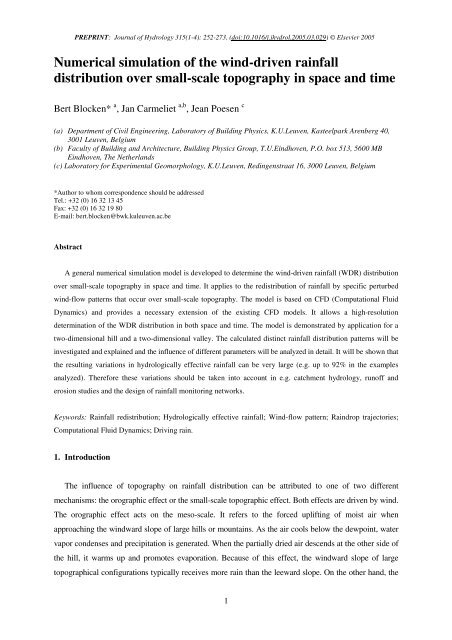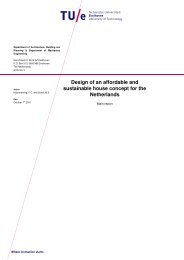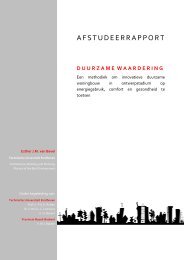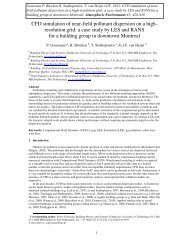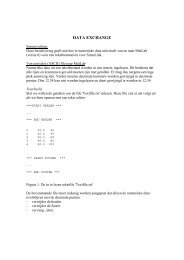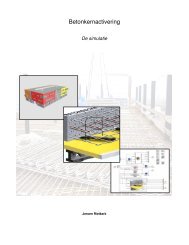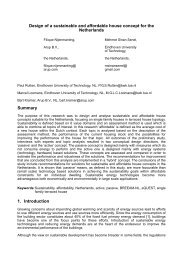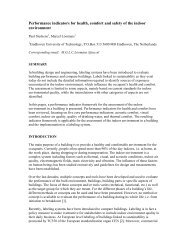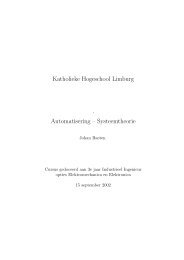Numerical simulation of the wind-driven rainfall distribution over ...
Numerical simulation of the wind-driven rainfall distribution over ...
Numerical simulation of the wind-driven rainfall distribution over ...
Create successful ePaper yourself
Turn your PDF publications into a flip-book with our unique Google optimized e-Paper software.
PREPRINT: Journal <strong>of</strong> Hydrology 315(1-4): 252-273. (doi:10.1016/j.jhydrol.2005.03.029) © Elsevier 2005<br />
<strong>Numerical</strong> <strong>simulation</strong> <strong>of</strong> <strong>the</strong> <strong>wind</strong>-<strong>driven</strong> <strong>rainfall</strong><br />
<strong>distribution</strong> <strong>over</strong> small-scale topography in space and time<br />
Bert Blocken* a , Jan Carmeliet a,b , Jean Poesen c<br />
(a) Department <strong>of</strong> Civil Engineering, Laboratory <strong>of</strong> Building Physics, K.U.Leuven, Kasteelpark Arenberg 40,<br />
3001 Leuven, Belgium<br />
(b) Faculty <strong>of</strong> Building and Architecture, Building Physics Group, T.U.Eindhoven, P.O. box 513, 5600 MB<br />
Eindhoven, The Ne<strong>the</strong>rlands<br />
(c) Laboratory for Experimental Geomorphology, K.U.Leuven, Redingenstraat 16, 3000 Leuven, Belgium<br />
*Author to whom correspondence should be addressed<br />
Tel.: +32 (0) 16 32 13 45<br />
Fax: +32 (0) 16 32 19 80<br />
E-mail: bert.blocken@bwk.kuleuven.ac.be<br />
Abstract<br />
A general numerical <strong>simulation</strong> model is developed to determine <strong>the</strong> <strong>wind</strong>-<strong>driven</strong> <strong>rainfall</strong> (WDR) <strong>distribution</strong><br />
<strong>over</strong> small-scale topography in space and time. It applies to <strong>the</strong> re<strong>distribution</strong> <strong>of</strong> <strong>rainfall</strong> by specific perturbed<br />
<strong>wind</strong>-flow patterns that occur <strong>over</strong> small-scale topography. The model is based on CFD (Computational Fluid<br />
Dynamics) and provides a necessary extension <strong>of</strong> <strong>the</strong> existing CFD models. It allows a high-resolution<br />
determination <strong>of</strong> <strong>the</strong> WDR <strong>distribution</strong> in both space and time. The model is demonstrated by application for a<br />
two-dimensional hill and a two-dimensional valley. The calculated distinct <strong>rainfall</strong> <strong>distribution</strong> patterns will be<br />
investigated and explained and <strong>the</strong> influence <strong>of</strong> different parameters will be analyzed in detail. It will be shown that<br />
<strong>the</strong> resulting variations in hydrologically effective <strong>rainfall</strong> can be very large (e.g. up to 92% in <strong>the</strong> examples<br />
analyzed). Therefore <strong>the</strong>se variations should be taken into account in e.g. catchment hydrology, run<strong>of</strong>f and<br />
erosion studies and <strong>the</strong> design <strong>of</strong> <strong>rainfall</strong> monitoring networks.<br />
Keywords: Rainfall re<strong>distribution</strong>; Hydrologically effective <strong>rainfall</strong>; Wind-flow pattern; Raindrop trajectories;<br />
Computational Fluid Dynamics; Driving rain.<br />
1. Introduction<br />
The influence <strong>of</strong> topography on <strong>rainfall</strong> <strong>distribution</strong> can be attributed to one <strong>of</strong> two different<br />
mechanisms: <strong>the</strong> orographic effect or <strong>the</strong> small-scale topographic effect. Both effects are <strong>driven</strong> by <strong>wind</strong>.<br />
The orographic effect acts on <strong>the</strong> meso-scale. It refers to <strong>the</strong> forced uplifting <strong>of</strong> moist air when<br />
approaching <strong>the</strong> <strong>wind</strong>ward slope <strong>of</strong> large hills or mountains. As <strong>the</strong> air cools below <strong>the</strong> dewpoint, water<br />
vapor condenses and precipitation is generated. When <strong>the</strong> partially dried air descends at <strong>the</strong> o<strong>the</strong>r side <strong>of</strong><br />
<strong>the</strong> hill, it warms up and promotes evaporation. Because <strong>of</strong> this effect, <strong>the</strong> <strong>wind</strong>ward slope <strong>of</strong> large<br />
topographical configurations typically receives more rain than <strong>the</strong> leeward slope. On <strong>the</strong> o<strong>the</strong>r hand, <strong>the</strong><br />
1
<strong>wind</strong>-<strong>driven</strong> rain (WDR) topographic effect is a small or micro-scale effect (length from 0.1 m to several<br />
1000s <strong>of</strong> meters and height from 0.1 m to several 100s <strong>of</strong> meters). This effect refers to <strong>the</strong> local and lowlevel<br />
re<strong>distribution</strong> <strong>of</strong> already generated rain due to <strong>the</strong> existence <strong>of</strong> specific local perturbed <strong>wind</strong>-flow<br />
patterns <strong>over</strong> small-scale topographical features. As such, it is not part <strong>of</strong> <strong>the</strong> rain producing process.<br />
Information from literature points out that <strong>the</strong>se two effects are separable. James (1964), citing Geiger,<br />
mentions that <strong>the</strong> orographic effect does not come into play on low hills that are not a factor in <strong>the</strong> rising.<br />
He reports that, as ascending air cools with approximately 1° per 100 m <strong>of</strong> vertical rise, a hill less than<br />
100 m higher than <strong>the</strong> surrounding area would not be subjected to this effect. On <strong>the</strong> o<strong>the</strong>r hand, <strong>the</strong><br />
study by Poreh and Mechrez (1984) proves that <strong>the</strong> effect <strong>of</strong> large-scale topography on <strong>the</strong> re<strong>distribution</strong><br />
<strong>of</strong> already generated <strong>rainfall</strong> is small.<br />
The orographic effect has been quite adequately dealt with in literature (e.g. Haiden et al. 1992, Basist<br />
et al. 1994, Barrow and Lettenmeier 1994, to mention just a few). The small-scale topographical effect<br />
however has received less attention. Publications providing indications <strong>of</strong> <strong>the</strong> latter effect were provided<br />
by James (1964), Geiger (1965, p. 419) and Hovind (1965). They reported <strong>rainfall</strong> measurements that<br />
indicated <strong>the</strong> existence <strong>of</strong> relatively fixed <strong>rainfall</strong> <strong>distribution</strong> patterns. Later, fur<strong>the</strong>r experimental<br />
research efforts adequately identifying <strong>the</strong> small-scale topographical effect were conducted by Sharon<br />
(1970), Sandsborg (1970), Reid (1973), Craig (1980), Sharon (1980, 1983), Sharon et al. (1988), Lentz<br />
et al. (1995) and Sharon and Arazi (1997).<br />
Knowledge <strong>of</strong> <strong>the</strong> small-scale <strong>distribution</strong> <strong>of</strong> WDR is important for a wide range <strong>of</strong> activities in earth<br />
sciences and meteorology, including studies <strong>of</strong> catchment hydrology (e.g. Sharon 1970, Reid 1973),<br />
run<strong>of</strong>f and erosion studies (e.g. Sharon 1983, Poesen 1985, 1986, 1988, Sharon et al. 1988, Goossens et<br />
al. 2000, Erpul et al. 2002, 2003), <strong>the</strong> design <strong>of</strong> <strong>rainfall</strong> monitoring networks (e.g. Hutchinson 1970) and<br />
<strong>the</strong> selection <strong>of</strong> representative positions for <strong>rainfall</strong> measurements (e.g. Fourcade 1942, Hamilton 1954,<br />
de Lima 1990). The <strong>rainfall</strong> <strong>distribution</strong> patterns are <strong>of</strong>ten too complex to be predicted without<br />
measurements or numerical modeling. Measurements, if conducted with care, can provide accurate<br />
information. Such a study was carried out by Sharon and Arazi (1997) to study <strong>the</strong> <strong>rainfall</strong> <strong>distribution</strong> in<br />
a small watershed. However, for general use, <strong>the</strong> measurement approach is not feasible, as measurements<br />
are <strong>of</strong>ten impractical, time-consuming and expensive. <strong>Numerical</strong> modeling could be a more suitable<br />
means <strong>of</strong> predicting <strong>rainfall</strong> <strong>distribution</strong>s. This was also indicated by Sharon and Arazi (1997), who<br />
stated that accurate measurements are in <strong>the</strong> first place a valuable tool for <strong>the</strong> verification <strong>of</strong> numerical<br />
models that can <strong>the</strong>n be used as a predictive tool.<br />
Only a few authors have employed numerical modeling. The first modeling efforts were made by<br />
Poreh and Mechrez (1984) and by Stout et al. (1993). These authors used analytical expressions for <strong>the</strong><br />
<strong>wind</strong> field and numerical calculations <strong>of</strong> <strong>the</strong> raindrop motion. Bradley et al. (1997) used a simple<br />
potential flow model in combination with <strong>the</strong> calculation <strong>of</strong> raindrop trajectories to study <strong>the</strong> <strong>rainfall</strong><br />
<strong>distribution</strong> <strong>over</strong> low hills (elevation up to 400 m). Up to now, full numerical studies – i.e. including<br />
2
numerical modeling <strong>of</strong> <strong>the</strong> <strong>wind</strong>-flow field – have only been performed by Arazi et al. (1997) and by<br />
Choi (2002). These research efforts have all provided valuable information.<br />
Despite <strong>the</strong> progress made, a lot <strong>of</strong> work remains to be done. To be useful in practice, <strong>the</strong> existing<br />
knowledge and calculation techniques should now be converted into a generalized numerical <strong>simulation</strong><br />
model that is extended into <strong>the</strong> time domain. This model will allow <strong>the</strong> WDR <strong>distribution</strong> to be<br />
determined in both space and time, for any type <strong>of</strong> topography and for any type <strong>of</strong> rain event.<br />
Fur<strong>the</strong>rmore, a thorough understanding <strong>of</strong> <strong>the</strong> interaction between <strong>wind</strong>, rain and small-scale topography<br />
and <strong>of</strong> <strong>the</strong> resulting complex WDR <strong>distribution</strong> patterns – even for very simple topographical features –<br />
has not yet been attained. Also a detailed analysis <strong>of</strong> <strong>the</strong> importance <strong>of</strong> <strong>the</strong> different influencing<br />
parameters, such as type <strong>of</strong> topography, <strong>wind</strong> speed, raindrop diameter and <strong>rainfall</strong> intensity has not yet<br />
been performed. The main objective <strong>of</strong> this study is to develop such a model and to apply it to identify<br />
and explain <strong>the</strong> distinct <strong>distribution</strong> patterns for a simple 2D hill and 2D valley configuration. Specific<br />
attention will be paid to <strong>the</strong> numerical accuracy <strong>of</strong> <strong>the</strong> calculations (modeling choices and error analysis)<br />
and to <strong>the</strong> detailed and systematic investigation <strong>of</strong> <strong>the</strong> influencing parameters.<br />
The model that is presented and applied is based on Computational Fluid Dynamics (CFD). It is<br />
important to note that confidence in using this type <strong>of</strong> model has been obtained earlier by <strong>the</strong> application<br />
and successful experimental validation <strong>of</strong> a similar model to obtain quantitative predictions <strong>of</strong> <strong>the</strong> WDR<br />
<strong>distribution</strong> on <strong>the</strong> vertical faces <strong>of</strong> bluff bodies (buildings) (Blocken and Carmeliet 2002, 2004).<br />
The paper starts with providing some definitions and <strong>the</strong> influencing parameters <strong>of</strong> WDR. Next, <strong>the</strong><br />
extended numerical model is developed and applied.<br />
2. Definitions and parameters<br />
Rainfall sum (S) is measured in L/m² or mm. Rainfall rate or intensity (R) is measured in L/m²h or<br />
mm/h. The <strong>rainfall</strong> sum or intensity measured by a conventional rain gauge with a horizontal orifice<br />
placed on level ground sufficiently far away from any obstructions and divided by <strong>the</strong> area A <strong>of</strong> <strong>the</strong><br />
orifice, is termed reference meteorological <strong>rainfall</strong> (R or S) (Fig. 1a). The <strong>rainfall</strong> measured by a<br />
conventional rain gauge placed on sloping ground, divided by <strong>the</strong> area A, will generally differ from <strong>the</strong><br />
reference meteorological <strong>rainfall</strong> due to <strong>the</strong> disturbance <strong>of</strong> <strong>the</strong> <strong>wind</strong>-flow pattern and <strong>the</strong> re<strong>distribution</strong> <strong>of</strong><br />
<strong>rainfall</strong> by <strong>the</strong> local topography. It is called <strong>the</strong> meteorological <strong>rainfall</strong> (R 0 or S 0 ) (Fig. 1b). The <strong>rainfall</strong><br />
measured by a tilted rain gauge with <strong>the</strong> orifice parallel to <strong>the</strong> ground surface, divided by <strong>the</strong> projected<br />
area <strong>of</strong> <strong>the</strong> rain gauge orifice (Acosθ), is called hydrological <strong>rainfall</strong> or hydrologically effective <strong>rainfall</strong><br />
(R* or S*) (Fig. 1c). The latter generally differs from <strong>the</strong> meteorological <strong>rainfall</strong> because <strong>of</strong> two reasons:<br />
<strong>the</strong> inclined orifice and <strong>the</strong> division by <strong>the</strong> projected area. This study will focus on <strong>the</strong> hydrological<br />
<strong>rainfall</strong> sum S* and on <strong>the</strong> hydrological <strong>rainfall</strong> intensity R*. The acronym WDR (<strong>wind</strong>-<strong>driven</strong> <strong>rainfall</strong>)<br />
will refer to <strong>the</strong>se quantities.<br />
3
To quantify <strong>the</strong> WDR <strong>distribution</strong>, we introduce two dimensionless parameters: <strong>the</strong> specific catch<br />
ratio η d (d,t) and <strong>the</strong> catch ratio η(t). The specific catch ratio is defined as <strong>the</strong> ratio <strong>of</strong> <strong>the</strong> hydrological<br />
<strong>rainfall</strong> intensity R*(d,t) and <strong>the</strong> reference meteorological <strong>rainfall</strong> intensity R(d,t), both at time t and only<br />
composed <strong>of</strong> raindrops with diameter d. The catch ratio is defined in a similar way, but it relates to <strong>the</strong><br />
entire spectrum <strong>of</strong> raindrop diameters: Eq. (1):<br />
R *(d, t)<br />
R *(t)<br />
η d<br />
(d, t) = , η(t) =<br />
(1)<br />
R(d, t)<br />
R(t)<br />
In practical applications, η d and η will be calculated for discrete time steps [t n , t n +∆t]. The (specific)<br />
catch ratio for a discrete time step is redefined as:<br />
η<br />
d<br />
(d, t<br />
n<br />
)<br />
=<br />
∫<br />
t n + ∆t<br />
t n<br />
t n + ∆t<br />
∫<br />
t n<br />
R * (d, t)<br />
R(d, t)<br />
dt<br />
dt<br />
=<br />
S* (d, t<br />
S(d, t<br />
n<br />
n<br />
)<br />
)<br />
,<br />
η(t<br />
n<br />
)<br />
=<br />
∫<br />
t n + ∆t<br />
t n<br />
t n + ∆t<br />
∫<br />
t n<br />
R * (t) dt<br />
R(t) dt<br />
=<br />
S* (t<br />
n<br />
)<br />
S(t )<br />
n<br />
(2)<br />
where S*(d,t n ) and S(d,t n ) are <strong>the</strong> hydrological <strong>rainfall</strong> sum and <strong>the</strong> reference meteorological <strong>rainfall</strong> sum<br />
for raindrops <strong>of</strong> diameter d during <strong>the</strong> time step. S*(t n ) and S(t n ) refer to <strong>the</strong> same quantities but<br />
integrated <strong>over</strong> <strong>the</strong> entire spectrum <strong>of</strong> raindrop diameters. When η has been determined, <strong>the</strong><br />
corresponding hydrological <strong>rainfall</strong> sum can be obtained by simply multiplying η with <strong>the</strong> reference<br />
meteorological <strong>rainfall</strong> sum.<br />
The catch ratio η is a complicated function <strong>of</strong> space and time. The six basic influencing parameters<br />
for η as defined in Eq. (2) are: (1) geometry <strong>of</strong> <strong>the</strong> topographic feature (including <strong>the</strong> geometry <strong>of</strong> <strong>the</strong><br />
surroundings), (2) position on <strong>the</strong> topography, (3) reference <strong>wind</strong> speed, (4) reference <strong>wind</strong> direction, (5)<br />
reference meteorological <strong>rainfall</strong> intensity and (6) horizontal raindrop-size <strong>distribution</strong>. The turbulent<br />
dispersion <strong>of</strong> raindrops will be neglected. Turbulent dispersion refers to <strong>the</strong> deviations in <strong>the</strong> motion <strong>of</strong><br />
falling raindrops caused by turbulent <strong>wind</strong> gusts. This will be discussed later. The reference <strong>wind</strong> speed<br />
U (also indicated by U 10 ) (m/s) refers to <strong>the</strong> horizontal component <strong>of</strong> <strong>the</strong> <strong>wind</strong> velocity vector at 10 m<br />
height in <strong>the</strong> upstream-undisturbed airflow <strong>over</strong> flat topography. The reference <strong>wind</strong> direction (ϕ, in<br />
degrees from north) refers to <strong>the</strong> direction <strong>of</strong> <strong>the</strong> reference <strong>wind</strong> speed. The horizontal raindrop-size<br />
<strong>distribution</strong> f h (d) (m -1 ) refers to <strong>the</strong> raindrop-size <strong>distribution</strong> as a flux through a horizontal plane, as<br />
opposed to <strong>the</strong> raindrop-size <strong>distribution</strong> in a volume <strong>of</strong> air (as it is usually specified).<br />
4
3. <strong>Numerical</strong> model<br />
The development <strong>of</strong> <strong>the</strong> numerical model starts from a steady-state <strong>simulation</strong> technique for raindrops<br />
in a <strong>wind</strong> field that is similar to <strong>the</strong> technique used by Arazi et al. (1997) and Choi (2002). This<br />
technique will be briefly outlined. Next, some important rain modeling issues that have been included in<br />
this study – and that are sometimes wrongfully neglected – will be discussed. Afterwards, <strong>the</strong> steadystate<br />
technique will be extended into <strong>the</strong> time domain. Finally, some important considerations about<br />
accuracy and reliability <strong>of</strong> <strong>the</strong> numerical model will be given.<br />
3.1. Steady-state numerical <strong>simulation</strong> technique<br />
The steady-state <strong>simulation</strong> technique consists <strong>of</strong> four steps:<br />
(1) The steady-state <strong>wind</strong>-flow pattern <strong>over</strong> <strong>the</strong> topographic feature is calculated using a CFD code.<br />
(2) Raindrop trajectories are obtained by injecting raindrops <strong>of</strong> different sizes in <strong>the</strong> calculated<br />
<strong>wind</strong>-flow pattern and by solving <strong>the</strong>ir equations <strong>of</strong> motion.<br />
(3) The specific catch ratio η d is determined based on <strong>the</strong> injection and end positions <strong>of</strong> <strong>the</strong><br />
calculated raindrop trajectories.<br />
(4) The catch ratio η is calculated from η d and <strong>the</strong> size <strong>distribution</strong> <strong>of</strong> raindrops.<br />
3.1.1. Steady-state <strong>wind</strong>-flow pattern<br />
The steady-state <strong>wind</strong>-flow pattern is determined by a CFD code that solves <strong>the</strong> complex 2D or 3D<br />
Reynolds-Averaged Navier-Stokes (RANS) equations for an incompressible flow with constant<br />
viscosity. Closure is obtained by adopting a turbulence model. In <strong>the</strong> present study, <strong>the</strong> “realizable” k-ε<br />
model developed by Shih et al. (1995) is used. The numerical procedure is started by constructing a<br />
model <strong>of</strong> <strong>the</strong> topographic feature under study and a computational domain around it in which <strong>the</strong> flow<br />
field will be solved. The control volume technique is used. It consists <strong>of</strong> dividing <strong>the</strong> computational<br />
domain into a large number <strong>of</strong> discrete control volumes: <strong>the</strong> computational mesh. The g<strong>over</strong>ning<br />
equations (RANS and turbulence model equations) are <strong>the</strong>n integrated for each control volume to obtain<br />
discretized algebraic equations. The latter equations express <strong>the</strong> conservation laws on a control volume<br />
basis and can be solved numerically. In <strong>the</strong> present paper, <strong>the</strong> equations are solved using second-order<br />
up<strong>wind</strong> discretization for <strong>the</strong> convection and diffusive terms. Pressure-velocity coupling is provided by<br />
<strong>the</strong> SIMPLE scheme. Pressure interpolation is performed with <strong>the</strong> standard scheme (Fluent Inc. 1998).<br />
The results <strong>of</strong> <strong>the</strong> calculation are <strong>the</strong> numerical values <strong>of</strong> <strong>the</strong> two (in 2D) or three (in 3D) <strong>wind</strong> speed<br />
components, pressure, k and ε at each control volume center point.<br />
5
3.1.2. Raindrop trajectories<br />
The raindrop trajectories are determined based on <strong>the</strong> calculated steady-state <strong>wind</strong>-flow pattern<br />
(velocity vectors V r ). The equation <strong>of</strong> motion <strong>of</strong> a raindrop is:<br />
⎛ ρ<br />
w<br />
⎜<br />
⎝ ρ<br />
- ρ<br />
w<br />
⎞ r 3µ<br />
⎟g<br />
+<br />
⎠ ρ<br />
wd<br />
2<br />
r<br />
C<br />
D<br />
Re ⎛ r dr ⎞<br />
⋅ ⋅ ⎜V - ⎟<br />
4 ⎝ dt ⎠<br />
=<br />
2r<br />
d<br />
2<br />
dt<br />
(3)<br />
where Re is <strong>the</strong> relative Reynolds number (referring to <strong>the</strong> airflow around an individual raindrop):<br />
Re<br />
ρd r<br />
r<br />
dr<br />
= V −<br />
(4)<br />
µ dt<br />
and ρ w is <strong>the</strong> density <strong>of</strong> <strong>the</strong> raindrop, ρ <strong>the</strong> air density, g <strong>the</strong> gravitational constant, C D <strong>the</strong> raindrop drag<br />
coefficient and r <strong>the</strong> position vector <strong>of</strong> <strong>the</strong> raindrop in <strong>the</strong> xyz-space. The raindrop trajectories can be<br />
calculated in a piecewise analytical manner (Blocken 2004). The raindrop drag coefficient will be<br />
discussed later.<br />
3.1.3. Specific catch ratio<br />
The calculation <strong>of</strong> <strong>the</strong> specific catch ratio η d is performed by <strong>the</strong> following procedure. For simplicity,<br />
a 2D situation is assumed (Fig. 2). In a steady-state <strong>wind</strong>-flow pattern – thus neglecting turbulent<br />
dispersion <strong>of</strong> raindrops – two trajectories <strong>of</strong> raindrops with diameter d form a stream tube. Let<br />
R<br />
d<br />
represent <strong>the</strong> rain intensity vector related to <strong>the</strong> raindrops <strong>of</strong> diameter d (L/m²h). The flux <strong>of</strong> this<br />
vector through <strong>the</strong> horizontal surface A h that is situated outside <strong>the</strong> disturbed <strong>wind</strong> field is equal to <strong>the</strong><br />
product <strong>of</strong> <strong>the</strong> reference meteorological <strong>rainfall</strong> intensity R(d) (L/m²h) and <strong>the</strong> surface area A h . This<br />
volume <strong>of</strong> <strong>rainfall</strong> per hour (L/h) flows through <strong>the</strong> stream tube and falls on <strong>the</strong> sloping soil surface A s .<br />
Conservation <strong>of</strong> mass for <strong>the</strong> raindrops in <strong>the</strong> stream tube allows η d to be expressed in terms <strong>of</strong> areas:<br />
R * (d) A<br />
h<br />
η<br />
d<br />
(d) = =<br />
(5)<br />
R(d) A cos θ<br />
s<br />
Here, A s cosθ is <strong>the</strong> horizontal projection <strong>of</strong> <strong>the</strong> slope area A s that is bounded by <strong>the</strong> trajectory endpoints.<br />
In <strong>the</strong> <strong>simulation</strong>, it is important that <strong>the</strong> location <strong>of</strong> <strong>the</strong> plane A h must allow <strong>the</strong> raindrops injected at that<br />
position to reach <strong>the</strong>ir terminal velocity <strong>of</strong> fall (vertical) and <strong>the</strong> <strong>wind</strong> velocity (horizontal) before<br />
entering <strong>the</strong> flow pattern disturbed by <strong>the</strong> topographic feature.<br />
6
3.1.4. Catch ratio<br />
The catch ratio η is obtained by multiplying η d for each raindrop diameter d with <strong>the</strong> fraction <strong>of</strong> <strong>the</strong>se<br />
drops in <strong>the</strong> rain (horizontal raindrop-size <strong>distribution</strong> f h (d)) and integrating <strong>over</strong> all raindrop diameters:<br />
∫<br />
η = f (d) η (d) d d<br />
(6)<br />
d<br />
h<br />
d<br />
3.2. Rain modeling considerations<br />
Drag coefficient formulae C D for spherical particles (Morsi and Alexander 1972) are <strong>of</strong>ten used in<br />
raindrop trajectory calculations, as only <strong>the</strong>se are available in many commercial CFD codes. As falling<br />
raindrops deviate from <strong>the</strong> spherical shape (Pruppacher and Klett 1978), <strong>the</strong>se drag coefficients are an<br />
underestimation <strong>of</strong> <strong>the</strong> real ones, especially at high relative Reynolds numbers. Appropriate drag<br />
coefficients for falling raindrops were measured by e.g. Gunn and Kinzer (1949) and have been<br />
implemented in <strong>the</strong> particle tracking procedures written by <strong>the</strong> current authors.<br />
As measuring raindrop-size <strong>distribution</strong>s with good accuracy is difficult (Salles et al. 1999) and such<br />
data are not generally available, information on raindrop-size spectra must be obtained from empirical<br />
formulae. For <strong>the</strong> present study, <strong>the</strong> formula <strong>of</strong> Best (1950) is adopted. It is supported by a wide<br />
bibliographical survey and by measurements for a large number <strong>of</strong> rain events. His findings indicated<br />
that in many cases <strong>the</strong> size <strong>distribution</strong> <strong>of</strong> raindrops is in good accordance with Eq. (7):<br />
F(d)<br />
⎛ n<br />
d ⎞<br />
F<br />
1 exp ⎜ ⎛ ⎞<br />
p<br />
d<br />
= − − ⎜ ⎟ ⎟ , a = A R , f(d) =<br />
(7)<br />
⎜ a ⎟<br />
⎝ ⎝ ⎠ ⎠<br />
d d<br />
where F(d) is <strong>the</strong> fraction <strong>of</strong> liquid water in <strong>the</strong> air with raindrops <strong>of</strong> diameter less than d and A, n, p are<br />
parameters <strong>the</strong> experimentally determined averages <strong>of</strong> which are 1.30, 2.25, 0.232 respectively. The<br />
function f(d) yields <strong>the</strong> probability density <strong>of</strong> drop size in a volume <strong>of</strong> air. Due to <strong>the</strong> variation <strong>of</strong> <strong>the</strong><br />
terminal velocity <strong>of</strong> fall <strong>of</strong> a raindrop with size, <strong>the</strong> raindrop-size <strong>distribution</strong> in a volume <strong>of</strong> air differs<br />
from <strong>the</strong> raindrop-size <strong>distribution</strong> as a flux through a horizontal plane. The former can be converted to<br />
<strong>the</strong> latter by multiplying with <strong>the</strong> raindrop terminal velocity <strong>of</strong> fall v t (d):<br />
f<br />
h<br />
(d)<br />
=<br />
∫<br />
d<br />
f(d) v<br />
t<br />
t<br />
(d)<br />
f(d) v (d) d d<br />
(8)<br />
7
where f h (d) represents <strong>the</strong> raindrop-size <strong>distribution</strong> through a horizontal plane and f(d) <strong>the</strong> raindrop-size<br />
<strong>distribution</strong> in <strong>the</strong> air. The denominator is necessary to ensure that <strong>the</strong> area under <strong>the</strong> curve f h (d) vs. d<br />
remains equal to unity. Results <strong>of</strong> raindrop terminal velocity measurements can be found in e.g. Gunn<br />
and Kinzer (1949). f h (d) is presented in Fig. 3 for various reference <strong>rainfall</strong> intensities.<br />
3.3. <strong>Numerical</strong> model for <strong>wind</strong>-<strong>driven</strong> <strong>rainfall</strong> <strong>distribution</strong> in space and time<br />
3.3.1. Objective <strong>of</strong> <strong>the</strong> model extension into <strong>the</strong> time domain<br />
Taking into account <strong>the</strong> rain modeling considerations described in section 3.2, <strong>the</strong> steady-state<br />
<strong>simulation</strong> technique (section 3.1) is incorporated into a generalized numerical <strong>simulation</strong> model. The<br />
objective <strong>of</strong> <strong>the</strong> numerical model is to predict both <strong>the</strong> spatial and temporal <strong>distribution</strong> <strong>of</strong> WDR <strong>over</strong><br />
topographic features for transient (i.e. time-varying) rain events. A rain event is defined here as a period<br />
<strong>of</strong> time <strong>of</strong> variable length during which it rains at least once, and that can be interspersed with periods<br />
without <strong>rainfall</strong>. The spatial WDR <strong>distribution</strong> is obtained by determining <strong>the</strong> catch ratio η at each<br />
position on <strong>the</strong> topography. The temporal <strong>distribution</strong> results from performing <strong>the</strong>se calculations for<br />
user-defined discrete time steps. The time scale at which <strong>the</strong> wea<strong>the</strong>r data samples are available is called<br />
<strong>the</strong> experimental time scale and <strong>the</strong> corresponding time step is noted as ∆t e (index i). The user-defined<br />
time scale at which <strong>the</strong> catch ratio is calculated is called <strong>the</strong> numerical time scale and <strong>the</strong> corresponding<br />
time step is noted as ∆t n (index j). The numerical time step is larger than or equal to <strong>the</strong> experimental<br />
time step and comprises an integer number <strong>of</strong> experimental time steps. The definitions <strong>of</strong> experimental<br />
and numerical time step are needed because <strong>the</strong> experimental data is usually high-resolution data, while<br />
<strong>the</strong> calculated results will <strong>of</strong>ten refer to larger time scales. The size <strong>of</strong> <strong>the</strong> numerical time step is<br />
determined by <strong>the</strong> application for which <strong>the</strong> calculated results will be used (e.g. water infiltration in soils:<br />
∆t n = 1 hour or 1 day, ∆t e = 1 or 10 minutes). Fig. 4 represents a schematic <strong>of</strong> input and output data in <strong>the</strong><br />
numerical model for ∆t e = 10 minutes and ∆t n = 1 hour.<br />
3.3.2. Methodology<br />
In <strong>the</strong> following, <strong>the</strong> discussion is limited to two dimensions. Recalling <strong>the</strong> six basic influencing<br />
parameters for <strong>the</strong> catch ratio η mentioned in section 2 and with <strong>wind</strong> direction dropping out in <strong>the</strong> 2D<br />
case, for a given topography and a given position on <strong>the</strong> topography, <strong>the</strong> catch ratio is a function <strong>of</strong> <strong>the</strong><br />
reference <strong>wind</strong> speed U, <strong>the</strong> reference <strong>rainfall</strong> intensity R and <strong>the</strong> horizontal raindrop-size <strong>distribution</strong><br />
f h (d). When <strong>the</strong> raindrop-size <strong>distribution</strong> <strong>of</strong> Best is adopted (Eq. 7 and 8), a unique relation exists<br />
between <strong>the</strong> reference <strong>rainfall</strong> intensity and <strong>the</strong> raindrop spectrum, causing <strong>the</strong> reference <strong>wind</strong> speed and<br />
<strong>rainfall</strong> intensity values to unambiguously define <strong>the</strong> catch ratio.<br />
8
The steady-state <strong>simulation</strong> technique can be used to calculate <strong>the</strong> catch ratio under steady-state<br />
conditions, i.e. for fixed values <strong>of</strong> reference <strong>wind</strong> speed and <strong>rainfall</strong> intensity. To determine <strong>the</strong> catch<br />
ratio for a transient rain event, with fluctuating <strong>wind</strong> speed and <strong>rainfall</strong> intensity, this event is partitioned<br />
into a number <strong>of</strong> equidistant time steps, each <strong>of</strong> which is considered steady-state. The time step length is<br />
taken equal to <strong>the</strong> experimental time step size ∆t e (see Fig. 4). This way, with each time step (index i), a<br />
measured value <strong>of</strong> reference <strong>wind</strong> speed U i (= U 10 ) and <strong>rainfall</strong> intensity R i is associated. For each<br />
(experimental) time step i, <strong>the</strong> corresponding catch ratio can now be calculated by employing <strong>the</strong> steadystate<br />
technique for <strong>the</strong> couple (U i , R i ).<br />
To reduce <strong>the</strong> computational expense, <strong>the</strong> steady-state technique will only be employed for a limited<br />
number <strong>of</strong> reference <strong>wind</strong> speed and <strong>rainfall</strong> intensity couples (U i , R i ), while intermediate results will be<br />
obtained by linear interpolation. A number <strong>of</strong> steady-state values for η are numerically calculated for<br />
particular positions on <strong>the</strong> topography and for various combinations <strong>of</strong> reference <strong>wind</strong> speed U (…U k ,<br />
U i , U k+1 , …) and <strong>rainfall</strong> intensity R (… R l , R i , R l+1 , ...). With <strong>the</strong>se values, catch ratio charts can be<br />
constructed as presented in Fig. 5a. Let us consider an experimental time step i in <strong>the</strong> rain event and let<br />
<strong>the</strong> corresponding couple (U i , R i ) be situated in segment (k,l) as shown in Fig. 5a:<br />
U<br />
k<br />
U<br />
i<br />
< U<br />
k+ 1<br />
, R<br />
l<br />
≤ R<br />
i<br />
< R<br />
l+<br />
1<br />
≤ (9)<br />
Each segment (k,l) is characterized by four calculated values for η (Fig. 5b). As <strong>the</strong>se values generally<br />
do not define a plane in <strong>the</strong> (U, R, η) space, <strong>the</strong> segment is split up into two partial segments (k,l) (1) and<br />
(k,l) (2) (Fig. 5b). Each <strong>of</strong> <strong>the</strong>se partial segments is characterized by three η-values that do define a plane.<br />
For each <strong>of</strong> <strong>the</strong>se partial segments, this plane is used as an approximation for <strong>the</strong> actual surface η = f(U,<br />
R). The value <strong>of</strong> <strong>the</strong> catch ratio η i for each couple (U i ,R i ) is <strong>the</strong>n extracted from <strong>the</strong> catch ratio chart by<br />
linear interpolation in <strong>the</strong>se planes. Finally, <strong>the</strong> catch ratio for <strong>the</strong> numerical time step j (η j ) is determined<br />
from <strong>the</strong> catch ratios for each <strong>of</strong> <strong>the</strong> experimental time steps i (η i ) that are comprised in <strong>the</strong> time step j.<br />
This is done by expressing that <strong>the</strong> summed hydrological <strong>rainfall</strong> sum <strong>over</strong> all <strong>the</strong> time steps i comprised<br />
in <strong>the</strong> time step j must equal <strong>the</strong> hydrological <strong>rainfall</strong> sum for time step j:<br />
*<br />
∑ = S j ⇔ ∑ ηiSi<br />
=<br />
i<br />
∑<br />
* η j S<br />
i i<br />
i<br />
i<br />
S (10)<br />
3.4. Accuracy and reliability<br />
The accuracy and reliability <strong>of</strong> <strong>the</strong> numerical <strong>simulation</strong> model is mainly g<strong>over</strong>ned by two modeling<br />
choices: (1) <strong>the</strong> numerical discretization and (2) <strong>the</strong> turbulence model.<br />
9
3.4.1. <strong>Numerical</strong> discretization<br />
The numerical discretization error <strong>of</strong> <strong>the</strong> CFD calculation <strong>of</strong> <strong>the</strong> <strong>wind</strong>-flow field depends on <strong>the</strong> size<br />
<strong>of</strong> <strong>the</strong> computational mesh, on <strong>the</strong> schemes employed for <strong>the</strong> discretization <strong>of</strong> <strong>the</strong> g<strong>over</strong>ning equations<br />
and on <strong>the</strong> variable gradients in <strong>the</strong> flow field. Second-order-accurate schemes are used whenever<br />
possible. Sometimes however, <strong>the</strong> calculation process becomes unstable and first-order-accurate schemes<br />
(which are more stable) have to be used. In order to minimize discretization errors in <strong>the</strong> calculation <strong>of</strong><br />
<strong>the</strong> <strong>wind</strong>-flow field, small control volume sizes should be used in regions where large flow gradients are<br />
expected, i.e. close to <strong>the</strong> surface <strong>of</strong> <strong>the</strong> topography and behind it, especially when flow separation and<br />
recirculation is expected to occur. The discretization error for <strong>the</strong> <strong>wind</strong>-flow field can be estimated by<br />
solving <strong>the</strong> same problem on several systematically refined meshes and by employing <strong>the</strong> formula<br />
proposed by Ferziger and Peric (1996) followed by Richardson extrapolation. Since <strong>the</strong> present paper<br />
focuses on <strong>the</strong> WDR <strong>distribution</strong>, we are primarily interested in <strong>the</strong> accuracy at which we can determine<br />
this <strong>distribution</strong>, ra<strong>the</strong>r than <strong>the</strong> <strong>wind</strong>-flow field. Therefore, a slightly different procedure can be<br />
followed. Several meshes with different mesh resolutions are made, including one very fine mesh. The<br />
construction <strong>of</strong> <strong>the</strong> meshes will be discussed later. To construct <strong>the</strong> very fine mesh, <strong>the</strong> length scale <strong>of</strong><br />
<strong>the</strong> control volumes in <strong>the</strong> finest <strong>of</strong> <strong>the</strong> o<strong>the</strong>r meshes is reduced by 4, meaning a total reduction with a<br />
factor 4² = 16 in two dimensions. The solution on <strong>the</strong> very fine mesh is considered as <strong>the</strong> reference<br />
solution, and <strong>the</strong> discretization error on each <strong>of</strong> <strong>the</strong> o<strong>the</strong>r meshes is estimated by comparing <strong>the</strong> catch<br />
ratio <strong>distribution</strong> obtained from that mesh with that from <strong>the</strong> reference solution. In section 4, <strong>the</strong> mesh<br />
that was finally chosen will be given as well as <strong>the</strong> corresponding estimate <strong>of</strong> <strong>the</strong> discretization error.<br />
3.4.2. Turbulence model<br />
The adequacy <strong>of</strong> a turbulence model to be used for specific flow types is typically determined by<br />
comparing <strong>the</strong> numerical results from this model with experimental data. For <strong>the</strong> present study, <strong>the</strong><br />
realizable k-ε model has been chosen for <strong>the</strong> following reasons:<br />
(1) The k-ε family <strong>of</strong> turbulence models is <strong>the</strong> most widely validated <strong>of</strong> all turbulence models and<br />
<strong>of</strong>fers a good compromise between robustness, economy and accuracy.<br />
(2) Flows <strong>over</strong> topographical features such as hills and valleys are <strong>of</strong>ten characterized by flow<br />
separation. The standard k-ε model is known to provide inferior performance in simulating<br />
separated flows. The realizable k-ε model has been validated for a wide range <strong>of</strong> flows including<br />
separated flows and has been found to perform substantially better than <strong>the</strong> standard k-ε model<br />
(Shih et al. 1995, Kim et al. 1997).<br />
10
(3) Finally, and most importantly, <strong>the</strong> use <strong>of</strong> <strong>the</strong> realizable k-ε model has been found to yield accurate<br />
quantitative predictions <strong>of</strong> <strong>the</strong> WDR <strong>distribution</strong> on <strong>the</strong> vertical faces <strong>of</strong> bluff obstacles (buildings)<br />
(Blocken and Carmeliet 2002, 2004).<br />
4. Application<br />
4.1. Geometry<br />
The model is applied to determine <strong>the</strong> WDR <strong>distribution</strong> <strong>over</strong> two sinusoidal topographic<br />
configurations: a 2D hill and a 2D valley. The geometry is defined by <strong>the</strong> following equation:<br />
H ⎡ ⎛ 4 x−<br />
L ⎞⎤<br />
z = ± ⎢1<br />
+ sin⎜<br />
π ⎟⎥<br />
(11)<br />
2 ⎣ ⎝ 2L ⎠⎦<br />
where <strong>the</strong> positive sign is used to describe <strong>the</strong> hill surface and <strong>the</strong> negative sign to describe <strong>the</strong> valley<br />
surface. The parameter L, hill or valley length, is 100 m. The height/depth H is 30 m. Fig. 6 illustrates<br />
<strong>the</strong> geometry.<br />
4.2. Steady-state numerical <strong>simulation</strong>s<br />
Steady-state numerical <strong>simulation</strong>s are conducted for a selected set <strong>of</strong> couples (U i , R i ) to construct<br />
catch ratio charts for each position on <strong>the</strong> topography. The <strong>simulation</strong>s comprise <strong>the</strong> calculation <strong>of</strong> <strong>the</strong><br />
<strong>wind</strong>-flow pattern, <strong>the</strong> raindrop trajectories, <strong>the</strong> specific catch ratio and <strong>the</strong> catch ratio.<br />
4.2.1. Wind-flow pattern<br />
Models <strong>of</strong> both configurations are placed in a computational domain that is 1500 m long and 300 m<br />
high. The typology and size <strong>of</strong> <strong>the</strong> mesh is indicated in Fig. 7. The domain is meshed in identically <strong>the</strong><br />
same way for <strong>the</strong> two configurations. It is divided into eight faces, each <strong>of</strong> which is meshed with<br />
triangular control volumes. The mesh size is increased from bottom to top <strong>of</strong> <strong>the</strong> domain. The<br />
configurations are placed in a boundary-layer flow with a power-law velocity inflow pr<strong>of</strong>ile with<br />
exponent α = 0.15, corresponding to smooth terrain (Eq. 12):<br />
U(z)<br />
U<br />
10 ⎝10<br />
α<br />
⎛ z ⎞<br />
= ⎜ ⎟<br />
(12)<br />
⎠<br />
11
The roughness <strong>of</strong> <strong>the</strong> hill and valley surface is taken as 0.03 m, which corresponds to a surface c<strong>over</strong>ed<br />
with short grass. The computational domain is discretized with 83874 and 82288 control volumes for <strong>the</strong><br />
hill and valley configuration respectively. The steady-state <strong>wind</strong>-flow pattern is calculated for reference<br />
<strong>wind</strong> speed U 10 = 1, 2, 3, 4, 5, 6, 8, 10, 15, 20, 25 and 30 m/s. Wind-flow pr<strong>of</strong>iles (horizontal velocity<br />
component) at various positions in <strong>the</strong> domain are given in Fig. 8. Note that Fig. 8 represents only part <strong>of</strong><br />
<strong>the</strong> computational domain. For <strong>the</strong> hill, a large increase in <strong>wind</strong> speed is observed near <strong>the</strong> crest. Flow<br />
separation just beyond <strong>the</strong> crest causes a large vortex (recirculating flow) in <strong>the</strong> lee. It clearly influences<br />
<strong>the</strong> flow for a considerable distance downstream <strong>of</strong> <strong>the</strong> hill. The valley modifies <strong>the</strong> <strong>wind</strong> flow only<br />
locally. Flow separation occurs at <strong>the</strong> upstream valley edge, causing a large recirculation vortex inside<br />
<strong>the</strong> valley. These features will have a significant influence on <strong>the</strong> raindrop trajectories and <strong>the</strong> (specific)<br />
catch ratio as will be shown in <strong>the</strong> next sections.<br />
4.2.2. Raindrop trajectories<br />
For each <strong>of</strong> <strong>the</strong> calculated <strong>wind</strong>-flow patterns, 2D Lagrangian particle tracking is performed for<br />
raindrops with 15 different diameters ranging from 0.5 to 1 mm in steps <strong>of</strong> 0.1 mm, from 1 to 2 mm in<br />
steps <strong>of</strong> 0.2 mm and from 2 to 6 mm in steps <strong>of</strong> 1 mm. Fig. 9 shows particle trajectories <strong>of</strong> 0.5, 1.0 and<br />
6.0 mm drops in <strong>the</strong> 5 m/s flow fields. In general, it is seen that for smaller drops, <strong>the</strong> trajectories are<br />
more inclined and <strong>the</strong>ir distortion near <strong>the</strong> hill and in <strong>the</strong> valley is more pronounced. For larger drops<br />
(higher inertia), <strong>the</strong> trajectories are less inclined and more rectilinear. In particular, three observations are<br />
made: (1) for <strong>the</strong> hill configuration, not only <strong>the</strong> raindrop trajectories ending on <strong>the</strong> hill itself are<br />
influenced by it but also those ending a considerable distance upstream and especially downstream <strong>of</strong> <strong>the</strong><br />
hill. This is not <strong>the</strong> case for <strong>the</strong> valley. This observation directly corresponds with <strong>the</strong> disturbance <strong>of</strong> <strong>the</strong><br />
<strong>wind</strong>-flow pattern described in <strong>the</strong> previous section. (2) At <strong>the</strong> <strong>wind</strong>ward slope <strong>of</strong> <strong>the</strong> hill, <strong>the</strong> trajectories<br />
ending on <strong>the</strong> upper half are swept upwards, while <strong>the</strong> trajectories ending on <strong>the</strong> lower half are deflected<br />
downwards. (3) The recirculation vortex in <strong>the</strong> lee <strong>of</strong> <strong>the</strong> hill and inside <strong>the</strong> valley is responsible for <strong>the</strong><br />
curvature <strong>of</strong> <strong>the</strong> raindrop trajectories in <strong>the</strong>se regions. Note that, since <strong>the</strong> raindrops were injected<br />
equidistantly from a straight horizontal line, <strong>the</strong> density <strong>of</strong> <strong>the</strong> raindrop trajectory endpoints – measured<br />
along a horizontal line – on <strong>the</strong> hill and valley surface is a direct measure <strong>of</strong> <strong>the</strong> quantity <strong>of</strong> WDR<br />
(specific catch ratio).<br />
4.2.3. Specific catch ratio<br />
To obtain high-resolution information, arrays <strong>of</strong> 300 raindrop trajectories with a spacing <strong>of</strong> 1 m are<br />
injected from a straight horizontal line at a height <strong>of</strong> about 100 m above <strong>the</strong> topography. Based on <strong>the</strong>se<br />
trajectories, η d is obtained following <strong>the</strong> procedure outlined in section 3.1.3. This procedure is performed<br />
for each reference <strong>wind</strong> speed and each raindrop diameter. The spatial variation <strong>of</strong> η d as a function <strong>of</strong><br />
12
eference <strong>wind</strong> speed and raindrop diameter is shown in Fig 10. The following observations are made<br />
(note that η d > 1 on a certain position implies that <strong>the</strong> hydrological <strong>rainfall</strong> sum/intensity at that position<br />
is larger than <strong>the</strong> reference meteorological <strong>rainfall</strong> sum/intensity):<br />
For <strong>the</strong> hill configuration:<br />
(1) Fig. 10a1: Influence <strong>of</strong> <strong>wind</strong> speed on η d : A distinct wetting pattern is found, and <strong>the</strong> gradients in<br />
this pattern become more pronounced as <strong>the</strong> <strong>wind</strong> speed increases. A first positive peak is present at<br />
<strong>the</strong> lower three quarters <strong>of</strong> <strong>the</strong> <strong>wind</strong>ward slope. The position <strong>of</strong> this peak value remains relatively<br />
fixed with increasing <strong>wind</strong> speed. Following this positive peak, a negative peak is observed that<br />
stretches from <strong>the</strong> upper part <strong>of</strong> <strong>the</strong> <strong>wind</strong>ward slope to <strong>the</strong> crest and a certain distance down <strong>the</strong> lee<br />
slope. It clearly gets wider as <strong>wind</strong> speed increases. Immediately following <strong>the</strong> negative peak is a<br />
second positive peak, <strong>the</strong> position <strong>of</strong> which is shifted downstream with higher <strong>wind</strong> speeds. It is<br />
noted that a value larger than unity is present even beyond 150 m, i.e. 50 m behind <strong>the</strong> leeward<br />
slope <strong>of</strong> <strong>the</strong> hill, due to <strong>the</strong> presence <strong>of</strong> <strong>the</strong> large recirculation vortex.<br />
(2) Fig. 10b1: Influence <strong>of</strong> raindrop size on η d : The first positive peak is most pronounced for <strong>the</strong> larger<br />
raindrops, whereas <strong>the</strong> opposite holds for <strong>the</strong> negative peak. The second positive peak vanishes for<br />
large raindrops.<br />
For <strong>the</strong> valley configuration:<br />
(1) Fig. 10a2: Influence <strong>of</strong> <strong>wind</strong> speed on η d : The wetting pattern exhibits a negative peak just beyond<br />
<strong>the</strong> upstream valley edge and a positive peak <strong>of</strong> approximately <strong>the</strong> same magnitude at <strong>the</strong> upper half<br />
<strong>of</strong> <strong>the</strong> <strong>wind</strong>-facing slope. In contrast to <strong>the</strong> hill configuration, <strong>the</strong> positions <strong>of</strong> <strong>the</strong> positive and<br />
negative peaks are quite fixed. At a <strong>wind</strong> speed <strong>of</strong> 10 m/s and above, secondary peaks appear<br />
resulting in a more complicated wetting pattern.<br />
(2) Fig. 10b2: Influence <strong>of</strong> raindrop size on η d : The influence <strong>of</strong> raindrop size is most apparent for <strong>the</strong><br />
larger drops: <strong>the</strong> maximum/minimum values are slightly increased and <strong>the</strong> positive and negative<br />
peaks are stretched more towards <strong>the</strong> center <strong>of</strong> <strong>the</strong> valley.<br />
Zooming into two selected positions on <strong>the</strong> hill and on <strong>the</strong> valley slope, <strong>the</strong> dependency <strong>of</strong> η d on<br />
reference <strong>wind</strong> speed and raindrop diameter can be represented with surface plots as shown in Fig. 11<br />
and Fig. 12. These plots are specifically displayed to indicate <strong>the</strong> complexity <strong>of</strong> determining <strong>the</strong> WDR<br />
<strong>distribution</strong>, even on simple 2D geometries as are studied here. Note that <strong>the</strong> scaling on <strong>the</strong> vertical axis<br />
is different for each figure.<br />
(1) Figure 11 (hill) illustrates <strong>the</strong> different behavior <strong>of</strong> η d at two positions on <strong>the</strong> <strong>wind</strong>ward slope. At 25<br />
m, i.e. at half <strong>the</strong> slope height, η d increases approximately linearly with <strong>wind</strong> speed from 1.0 to<br />
about 2.5. An increase with raindrop diameter is observed, but only for <strong>the</strong> smaller drops (d = 0.5 –<br />
2.0 mm). At 42 m, near <strong>the</strong> crest, η d increases slightly with <strong>wind</strong> speed for values below 10 m/s<br />
(from 1.0 to about 1.2). Above 10 m/s, it decreases and <strong>the</strong> decrease is most pronounced for <strong>the</strong><br />
13
smaller drops. The reason is that <strong>the</strong> drops tend to be blown <strong>over</strong> <strong>the</strong> crest as <strong>the</strong> <strong>wind</strong> speed<br />
increases and <strong>the</strong> raindrop diameter decreases.<br />
(2) Figure 12 (valley) displays η d at positions just beyond <strong>the</strong> upstream valley edge (10 m) and at half<br />
<strong>the</strong> height <strong>of</strong> <strong>the</strong> downstream slope (75 m). Note that it was necessary to invert <strong>the</strong> direction <strong>of</strong> <strong>the</strong><br />
horizontal axes in <strong>the</strong> left figure in order to clearly illustrate <strong>the</strong> surface plot. At x = 10 m, η d<br />
decreases with increasing <strong>wind</strong> speed (from 1.0 to 0.3), and <strong>the</strong> behavior is quite similar for all drop<br />
sizes. The reason is again that <strong>the</strong> drops tend to be blown <strong>over</strong> this position. At x = 75 m, an<br />
increase with <strong>wind</strong> speed is found with a significantly different behavior for different drops (η d<br />
ranges from 1.0 to 1.6 for <strong>the</strong> largest drops).<br />
4.2.4. Catch ratio<br />
The catch ratio η is obtained by integrating η d <strong>over</strong> <strong>the</strong> raindrop spectrum (Eq. 6). This calculation is<br />
performed for each <strong>of</strong> <strong>the</strong> 13 <strong>wind</strong> speed values (U 10 = 0 m/s up to 30 m/s) and for 19 reference <strong>rainfall</strong><br />
intensity values (R = 0, 0.1, 0.5, 1, 2, 3, 4, 5, 6, 8, 10, 15, 20, 25, 30, 40, 50, 60, 80 mm/h).<br />
Fig. 13 shows <strong>the</strong> resulting η-pr<strong>of</strong>iles for a limited number <strong>of</strong> reference <strong>wind</strong> speed and <strong>rainfall</strong><br />
intensity values. The wetting pattern exhibits <strong>the</strong> same features as explained in <strong>the</strong> previous section.<br />
Wind speed clearly is <strong>the</strong> most important variable. The <strong>over</strong>all influence <strong>of</strong> <strong>rainfall</strong> intensity appears to<br />
be ra<strong>the</strong>r small for most positions.<br />
Finally, Fig. 14 and 15 provide <strong>the</strong> charts for η: <strong>the</strong> catch ratio charts. The important influence <strong>of</strong><br />
<strong>wind</strong> speed and <strong>the</strong> lesser influence <strong>of</strong> <strong>rainfall</strong> intensity are confirmed. Charts like <strong>the</strong>se were generated<br />
for a large number <strong>of</strong> positions along <strong>the</strong> topography and <strong>the</strong> corresponding values for η were digitally<br />
stored as matrices during <strong>the</strong> calculation process. These charts and matrices constitute <strong>the</strong> information<br />
that is necessary to perform <strong>the</strong> <strong>simulation</strong>s <strong>of</strong> <strong>the</strong> WDR <strong>distribution</strong> in time and space for time-varying<br />
rain events, as will be shown in section 4.3.<br />
4.2.5. Discretization error<br />
This section applies to <strong>the</strong> discretization error (and hence <strong>the</strong> numerical accuracy) <strong>of</strong> <strong>the</strong> calculation<br />
results shown above. From <strong>the</strong> numerical <strong>simulation</strong>s <strong>of</strong> raindrops in <strong>wind</strong> fields it has appeared that <strong>the</strong><br />
combination <strong>of</strong> high <strong>wind</strong> speed and small drops is most difficult to simulate, as especially <strong>the</strong> small<br />
drops are sensitive to small deviations (and hence also errors) in <strong>wind</strong> speed. Larger drops, with more<br />
inertia, are less sensitive. Therefore, estimates <strong>of</strong> <strong>the</strong> discretization error for <strong>the</strong> catch ratio calculation<br />
were determined for <strong>the</strong> most critical conditions: <strong>the</strong> highest <strong>wind</strong> speed (U 10 = 30 m/s) and <strong>the</strong> lowest<br />
<strong>rainfall</strong> intensity (R = 0.1 mm/h, i.e. a large fraction <strong>of</strong> small drops in <strong>the</strong> rain, see Fig. 3). Additionally,<br />
discretization errors were also determined for R = 1 mm/h and 10 mm/h to demonstrate <strong>the</strong> decreased<br />
14
sensitivity <strong>of</strong> large raindrops to <strong>wind</strong> speed deviations. The discretization errors were calculated as<br />
follows: at every data point along <strong>the</strong> transect, <strong>the</strong> absolute value was obtained <strong>of</strong> <strong>the</strong> difference between<br />
<strong>the</strong> η-value obtained from <strong>the</strong> very fine mesh and <strong>the</strong> η-value obtained from <strong>the</strong> mesh that was used for<br />
<strong>the</strong> <strong>simulation</strong>s in <strong>the</strong> previous sections. These absolute values were summed for all data points and<br />
divided by <strong>the</strong> number <strong>of</strong> points, providing a measure <strong>of</strong> <strong>the</strong> average error. The very fine mesh consisted<br />
<strong>of</strong> <strong>over</strong> 10 6 control volumes and was constructed in <strong>the</strong> same way as <strong>the</strong> o<strong>the</strong>r meshes (see Fig. 7) but<br />
with a four times smaller control volume length scale. For <strong>the</strong> hill, <strong>the</strong> resulting errors were 5.7%, 5.1%,<br />
3.7 % and for <strong>the</strong> valley: 6.0%, 3.0%, 2.5% for R = 0.1, 1, 10 mm/h respectively. The larger part <strong>of</strong> <strong>the</strong>se<br />
errors is due to small shifts <strong>of</strong> <strong>the</strong> negative and/or positive peak values, resulting in large differences at<br />
<strong>the</strong> data points (topographic positions) near <strong>the</strong> peaks. Anyway, <strong>the</strong> errors were considered small and<br />
given <strong>the</strong> fact that <strong>the</strong> most critical conditions were examined, <strong>the</strong> selected meshes were considered fit<br />
for purpose.<br />
4.3. Wind-<strong>driven</strong> <strong>rainfall</strong> <strong>distribution</strong> in time and space<br />
4.3.1. Rain event<br />
The numerical model is applied to determine <strong>the</strong> WDR <strong>distribution</strong> in time and space for an example<br />
rain event. The record <strong>of</strong> reference <strong>wind</strong> speed and <strong>rainfall</strong> intensity is given in Fig. 16a. The rain event<br />
is characterized by a period <strong>of</strong> low <strong>wind</strong> speed followed by a period <strong>of</strong> relatively high <strong>wind</strong> speed values.<br />
During each <strong>of</strong> <strong>the</strong>se periods, a number <strong>of</strong> rain spells with small to moderate intensity occur. The total<br />
volume <strong>of</strong> reference meteorological <strong>rainfall</strong> that was collected at <strong>the</strong> end <strong>of</strong> <strong>the</strong> rain event is 41 mm. The<br />
procedure described in section 3.3 is now followed to determine <strong>the</strong> WDR <strong>distribution</strong> in time and space.<br />
The experimental time step is 10 minutes (measurement interval), <strong>the</strong> numerical time step is – arbitrarily<br />
– also taken as 10 minutes.<br />
4.3.2. Wind-<strong>driven</strong> <strong>rainfall</strong> <strong>distribution</strong> in time<br />
Fig. 16b illustrates <strong>the</strong> <strong>distribution</strong> <strong>of</strong> <strong>the</strong> cumulative WDR sum (hydrological <strong>rainfall</strong>) toge<strong>the</strong>r with<br />
<strong>the</strong> cumulative reference meteorological <strong>rainfall</strong> sum during <strong>the</strong> rain event, at <strong>the</strong> positions 25 m and 42<br />
m for <strong>the</strong> hill and <strong>the</strong> positions 10 m and 75 m for <strong>the</strong> valley. The positions <strong>the</strong>mselves are illustrated in<br />
Fig. 14 and 15. The specific features <strong>of</strong> <strong>the</strong> time <strong>distribution</strong> can be studied by combining Fig. 14 and 15<br />
with Fig. 16. It is clear that <strong>the</strong> largest differences in 10-minute hydrological <strong>rainfall</strong> sum for <strong>the</strong> different<br />
positions occur during <strong>the</strong> co-occurrence <strong>of</strong> high <strong>wind</strong> speed values and peak <strong>rainfall</strong> intensity values. In<br />
<strong>the</strong> first 300 time steps (3000 minutes), <strong>wind</strong> speed is low and differences are too. The reason is that for<br />
low <strong>wind</strong> speed values, η is about 1.0 for all positions (see Fig. 14 and 15). The differences significantly<br />
increase with increasing <strong>wind</strong> speed (time step 340 and following). The cumulative hydrological <strong>rainfall</strong><br />
15
sum at hill position 42 and <strong>the</strong> cumulative reference <strong>rainfall</strong> sum coincide most <strong>of</strong> <strong>the</strong> time. The reason is<br />
that <strong>the</strong> positive and negative differences between η and unity (see Fig. 14b) average out for <strong>the</strong> rain<br />
event considered.<br />
4.3.3. Wind-<strong>driven</strong> <strong>rainfall</strong> <strong>distribution</strong> in space<br />
The spatial <strong>distribution</strong> <strong>of</strong> <strong>the</strong> WDR sum at <strong>the</strong> end <strong>of</strong> <strong>the</strong> rain event is given in Fig. 17. The dashed<br />
horizontal line indicates <strong>the</strong> total reference meteorological <strong>rainfall</strong> sum (41 mm). The wetting patterns<br />
clearly exhibit <strong>the</strong> same features as discussed before. Very large differences in total hydrological <strong>rainfall</strong><br />
sum are found along <strong>the</strong> topography. The difference between maximum and minimum amount on <strong>the</strong> hill<br />
is 92% <strong>of</strong> <strong>the</strong> reference <strong>rainfall</strong> sum. For <strong>the</strong> valley this value is 71%.<br />
5. Discussion<br />
• The application <strong>of</strong> <strong>the</strong> model in this paper has focused on <strong>the</strong> WDR <strong>distribution</strong> <strong>over</strong> two 2D, simple<br />
and <strong>the</strong>oretical topographic configurations, as a first step towards more complex <strong>simulation</strong>s. It is<br />
important to note that <strong>the</strong> developed model can be applied for any type <strong>of</strong> small-scale topography, in<br />
two as well as in three dimensions. The extension <strong>of</strong> <strong>the</strong> model itself to three dimensions is<br />
straightforward: solving <strong>the</strong> 3D RANS equations and adding <strong>the</strong> <strong>wind</strong> direction as a variable in <strong>the</strong><br />
catch ratio charts and in <strong>the</strong> interpolation procedure. However, accurate 3D CFD modeling <strong>of</strong> WDR<br />
<strong>over</strong> complex topography will require considerably larger computing resources and computing time.<br />
It is an important subject <strong>of</strong> future research.<br />
• In performing <strong>the</strong> numerical <strong>simulation</strong>s, efforts have been made to limit errors: <strong>the</strong> adequacy <strong>of</strong> <strong>the</strong><br />
resolution <strong>of</strong> <strong>the</strong> mesh has been verified (discretization error) and a suitable turbulence model was<br />
selected based on earlier experimental verification and validation studies <strong>of</strong> WDR. Never<strong>the</strong>less, a<br />
number <strong>of</strong> assumptions have been made that can introduce some error:<br />
(1) A first assumption is adopting <strong>the</strong> raindrop-size <strong>distribution</strong> <strong>of</strong> Best. Although this formula is<br />
based on an extensive study for a large number <strong>of</strong> rain events, deviations from <strong>the</strong> prescribed<br />
spectra are likely to occur. However, <strong>the</strong> influence <strong>of</strong> drop size and <strong>of</strong> reference <strong>rainfall</strong> intensity<br />
(and hence <strong>of</strong> raindrop-size <strong>distribution</strong>) on <strong>the</strong> WDR <strong>distribution</strong> has been found to be relatively<br />
small in <strong>the</strong> above <strong>simulation</strong>s. Fur<strong>the</strong>rmore, in earlier modeling work on WDR, using <strong>the</strong><br />
spectrum <strong>of</strong> Best has been shown to provide accurate quantitative <strong>simulation</strong> results (Blocken<br />
and Carmeliet 2002, 2004). Although both remarks indicate that <strong>the</strong> influence <strong>of</strong> <strong>the</strong> choice <strong>of</strong><br />
<strong>the</strong> raindrop spectrum is small, fur<strong>the</strong>r research efforts are needed to systematically investigate<br />
<strong>the</strong> sensitivity <strong>of</strong> <strong>the</strong> numerical prediction to changes in raindrop-size <strong>distribution</strong>.<br />
(2) The presented numerical model does not take into account <strong>the</strong> turbulent dispersion <strong>of</strong> raindrops<br />
in <strong>the</strong> <strong>wind</strong> field. Experimental verification efforts <strong>of</strong> a similar numerical model for <strong>the</strong> case <strong>of</strong><br />
16
<strong>the</strong> vertical faces <strong>of</strong> a low-rise bluff obstacle (building) have indicated that turbulent dispersion<br />
can be neglected (Blocken and Carmeliet 2002, 2004). Never<strong>the</strong>less, this statement should be<br />
verified for <strong>the</strong> more general case <strong>of</strong> random topographical configurations.<br />
(3) In <strong>the</strong> application <strong>of</strong> this study, 10-minute wea<strong>the</strong>r data was used as input. The natural<br />
fluctuations <strong>of</strong> <strong>wind</strong> and rain characteristics (see Fig. 16a) might suggest that measurements on a<br />
shorter experimental time scale are needed. On <strong>the</strong> o<strong>the</strong>r hand, meteorological data are <strong>of</strong>ten<br />
only made available on an hourly or daily basis. A study investigating <strong>the</strong> errors associated with<br />
<strong>the</strong> choice <strong>of</strong> <strong>the</strong> experimental time step is necessary.<br />
• The entire procedure as outlined in this paper might seem time-consuming. However it is important to<br />
note that this is only <strong>the</strong> case for <strong>the</strong> construction <strong>of</strong> <strong>the</strong> catch ratio charts (more specifically, <strong>the</strong> CFD<br />
<strong>wind</strong>-flow <strong>simulation</strong>s take more than 90% <strong>of</strong> <strong>the</strong> time – in 3D this percentage will be even higher).<br />
The set <strong>of</strong> steady-state <strong>simulation</strong>s conducted for <strong>the</strong> present paper has taken 7 days on a workstation<br />
with 2 processors <strong>of</strong> 2 GHz and 3 Gbyte RAM, only 2 Gbyte <strong>of</strong> which has been used. The most timeconsuming<br />
part (4 days) was performing a selected number <strong>of</strong> additional calculations on <strong>the</strong> very fine<br />
mesh to examine <strong>the</strong> discretization error. Without this, <strong>the</strong> entire set <strong>of</strong> <strong>simulation</strong>s would have been<br />
finished within 3 days. Once <strong>the</strong> catch ratio charts are constructed for a given topography, predicting<br />
<strong>the</strong> spatial and temporal WDR <strong>distribution</strong> for any rain event takes only a few minutes.<br />
6. Conclusions<br />
• A numerical <strong>simulation</strong> model has been presented as a tool that can be used in hydrological studies. It<br />
predicts <strong>the</strong> WDR (<strong>wind</strong>-<strong>driven</strong> <strong>rainfall</strong>) <strong>distribution</strong> <strong>over</strong> small-scale topography in space and time.<br />
The model consists <strong>of</strong> setting up <strong>of</strong> catch ratio charts to be used in combination with standard<br />
meteorological data (reference <strong>wind</strong> speed, reference <strong>wind</strong> direction, reference meteorological<br />
<strong>rainfall</strong> intensity). The charts are constructed by conducting a set <strong>of</strong> steady-state numerical<br />
<strong>simulation</strong>s <strong>of</strong> <strong>wind</strong>-flow and <strong>rainfall</strong> <strong>distribution</strong>. These <strong>simulation</strong>s are <strong>the</strong> most time-consuming<br />
part <strong>of</strong> <strong>the</strong> model. Once <strong>the</strong> construction <strong>of</strong> <strong>the</strong> charts has been completed for a given topography, <strong>the</strong><br />
WDR <strong>distribution</strong> for any rain event and at any time can be quickly numerically predicted. The<br />
results can be used for studies <strong>of</strong> catchment hydrology, for run<strong>of</strong>f and erosion studies and for <strong>the</strong><br />
design <strong>of</strong> <strong>rainfall</strong> monitoring networks, for example.<br />
• Confidence in using this type <strong>of</strong> model in hydrological studies has been obtained earlier by <strong>the</strong> use<br />
and successful validation <strong>of</strong> a similar model to obtain quantitative predictions <strong>of</strong> <strong>the</strong> WDR<br />
<strong>distribution</strong> on <strong>the</strong> vertical faces <strong>of</strong> bluff bodies (buildings) (Blocken and Carmeliet 2002, 2004).<br />
• The model has been applied for two sinusoidal topographies: a 2D hill and a 2D valley. An error<br />
analysis has been performed to select an appropriate numerical mesh. The numerical <strong>simulation</strong> <strong>of</strong><br />
WDR <strong>over</strong> <strong>the</strong> hill and valley has revealed <strong>the</strong> relationship between <strong>the</strong> <strong>wind</strong>-flow pattern, <strong>the</strong><br />
raindrop diameter, <strong>the</strong> <strong>rainfall</strong> intensity and <strong>the</strong> WDR <strong>distribution</strong> pattern. The most important<br />
17
influencing parameters are <strong>the</strong> geometry <strong>of</strong> <strong>the</strong> topography and <strong>the</strong> <strong>wind</strong> speed. The influence <strong>of</strong><br />
<strong>rainfall</strong> intensity on <strong>the</strong> catch ratio charts is less important.<br />
• Fur<strong>the</strong>r research efforts will concentrate on examining <strong>the</strong> importance <strong>of</strong> <strong>the</strong> assumptions mentioned<br />
in section 5, on <strong>the</strong> study <strong>of</strong> <strong>the</strong> WDR <strong>distribution</strong> <strong>over</strong> different and more complex topographical<br />
configurations and on <strong>the</strong> experimental verification <strong>of</strong> <strong>the</strong> predicted <strong>distribution</strong> patterns.<br />
Acknowledgements<br />
The first author is a post-doctoral research fellow <strong>of</strong> <strong>the</strong> FWO-Flanders (Belgium). The FWO-<br />
Flanders (Research Fund) supports and stimulates fundamental research in Flanders. Their contribution<br />
is gratefully acknowledged.<br />
Nomenclature<br />
A<br />
A h<br />
A s<br />
area <strong>of</strong> rain gauge orifice (m²)<br />
area <strong>of</strong> horizontal plane at a certain height in <strong>the</strong> unobstructed airflow (m²)<br />
area on sloping soil surface bounded by trajectory endpoints (m²).<br />
A, n, p constants in drop-size <strong>distribution</strong> equation (-)<br />
C D drag coefficient (-)<br />
d<br />
raindrop diameter (mm)<br />
F(d) fraction <strong>of</strong> liquid water in <strong>the</strong> air with raindrops <strong>of</strong> diameter less than d (-)<br />
f probability density <strong>of</strong> drop size in <strong>the</strong> air (m -1 )<br />
f h probability density <strong>of</strong> drop size through a horizontal plane (m -1 )<br />
H<br />
height <strong>of</strong> hill / depth <strong>of</strong> valley (m)<br />
i, j number <strong>of</strong> experimental / numerical time step<br />
k, l segment numbers<br />
k turbulent kinetic energy (m²s - ²)<br />
L<br />
r<br />
R<br />
R 0<br />
hill / valley length (m)<br />
position vector in xyz-space (m)<br />
reference meteorological <strong>rainfall</strong> intensity (level terrain) (mm/h or L/m²h)<br />
meteorological <strong>rainfall</strong> intensity (unlevel terrain) (mm/h or L/m²h)<br />
R* hydrological <strong>rainfall</strong> intensity (unlevel terrain) (mm/h or L/m²h)<br />
R <strong>rainfall</strong> intensity vector related to raindrop diameter d (mm/h or L/m²h)<br />
d<br />
Re Reynolds number (-)<br />
S<br />
S 0<br />
reference meteorological <strong>rainfall</strong> sum (level terrain) (mm or L/m²)<br />
meteorological <strong>rainfall</strong> sum (unlevel terrain) (mm or L/m²)<br />
S* hydrological <strong>rainfall</strong> sum (unlevel terrain) (mm or L/m²)<br />
t<br />
time (s)<br />
U horizontal component <strong>of</strong> mean <strong>wind</strong> speed (ms -1 )<br />
U 10 reference <strong>wind</strong> speed (upstream hor. <strong>wind</strong> velocity component at 10 m height) (ms -1 )<br />
18
v t raindrop terminal velocity <strong>of</strong> fall (ms -1 )<br />
x, z length and height co-ordinate (m)<br />
α power law exponent (-)<br />
γ angle <strong>of</strong> raindrop trajectory (°)<br />
ε turbulence dissipation rate (m²s -3 )<br />
θ slope angle (°)<br />
∆t<br />
time interval (s)<br />
η d , η specific catch ratio, catch ratio (-)<br />
µ molecular dynamic viscosity (kgm -1 s -1 )<br />
ϕ<br />
reference <strong>wind</strong> direction (direction <strong>of</strong> reference <strong>wind</strong> speed) (° from north)<br />
ρ, ρ w air density, water density (kgm - ³)<br />
References<br />
1. Arazi, A., Sharon, D., Khain, A., Huss, A., Mahrer, Y. 1997. The <strong>wind</strong>field and <strong>rainfall</strong> <strong>distribution</strong><br />
induced within a small valley: field observations and 2-D numerical modeling. Bound-Layer Meteorology<br />
83, 349-374.<br />
2. Barrow, A.P., Lettenmeier, D.P. 1994. Dynamic modeling <strong>of</strong> orographically-induced precipitation. Rev.<br />
Geophys. 32, 265-284.<br />
3. Basist, A., Bell, G.D., Meentemeyer, V. 1994. Statistical relationships between topography and<br />
precipitation patterns. Journal <strong>of</strong> Climate 7(9), 1305-1315.<br />
4. Best, A.C. 1950. The size <strong>distribution</strong> <strong>of</strong> raindrops. Quarterly Journal <strong>of</strong> <strong>the</strong> Royal Meteorological Society<br />
76, 16-36.<br />
5. Blocken, B. 2004. Wind-<strong>driven</strong> rain on buildings: measurements, numerical modelling and applications.<br />
Ph.D. <strong>the</strong>sis, Laboratory <strong>of</strong> Building Physics, Department <strong>of</strong> Civil Engineering, Katholieke Universiteit<br />
Leuven, 323 p.<br />
6. Blocken, B., Carmeliet, J. 2002. Spatial and temporal <strong>distribution</strong> <strong>of</strong> driving rain on a low-rise building.<br />
Wind and Structures 5(5), 441-462.<br />
7. Blocken, B., Carmeliet, J. 2004. A review <strong>of</strong> <strong>wind</strong>-<strong>driven</strong> rain research in building science. Journal <strong>of</strong> Wind<br />
Engineering and Industrial Aerodynamics 92(13), 1079-1130.<br />
8. Bradley, S.G., Gray, W.R., Pigott, L.D., Seed, A.W., Stow, C.D., Austin, G.L. 1997. Rainfall re<strong>distribution</strong><br />
<strong>over</strong> low hills due to flow perturbation. Journal <strong>of</strong> Hydrology 202, 33-47.<br />
9. Choi, E.C.C. 2002. Modelling <strong>of</strong> <strong>wind</strong>-<strong>driven</strong> rain and its soil detachment effect on hill slopes. Journal <strong>of</strong><br />
Wind Engineering and Industrial Aerodynamics 90 (9), 1081-1097.<br />
10. Craig, D. 1980. Two examples <strong>of</strong> <strong>the</strong> effect <strong>of</strong> topography on <strong>rainfall</strong> <strong>distribution</strong> patterns. Wea<strong>the</strong>r 35(10),<br />
301-307.<br />
11. De Lima, J.L.M.P. 1990. The effect <strong>of</strong> oblique rain on inclined surfaces: a nomograph for <strong>the</strong> rain-gauge<br />
correction factor. Journal <strong>of</strong> Hydrology 115, 407-412.<br />
12. Erpul, G., Norton, L.D., Gabriëls, D. 2002. Raindrop-induced and <strong>wind</strong>-<strong>driven</strong> soil particle transport.<br />
Catena 47(3), 227-243.<br />
13. Erpul, G., Norton, L.D., Gabriëls, D. 2003. Sediment transport from interril areas under <strong>wind</strong>-<strong>driven</strong> rain.<br />
Journal <strong>of</strong> Hydrology 276(1-4), 184-197.<br />
14. Ferziger, J.H., Peric, M. 1996. Computational methods for fluid dynamics. Springer Berlin, 356p.<br />
15. Fluent Inc. 1998. Fluent 5 User’s manual.<br />
16. Fourcade, H.G. 1942. Some notes on <strong>the</strong> effects <strong>of</strong> <strong>the</strong> incidence <strong>of</strong> rain on <strong>the</strong> <strong>distribution</strong> <strong>of</strong> <strong>rainfall</strong> <strong>over</strong><br />
<strong>the</strong> surface <strong>of</strong> unlevel ground. Transactions <strong>of</strong> <strong>the</strong> Royal Society <strong>of</strong> South-Africa 29(3), 235-254.<br />
17. Geiger, R. 1965. The climate near <strong>the</strong> ground, Harvard University Press, Cambridge, 611 p.<br />
18. Goossens, D., Poesen, J., Gross, J., Spaan, W. 2000. Splash drift on light sandy soils: a field experiment.<br />
Agronomie 20, 271-282.<br />
19. Gunn, R., Kinzer, G.D. 1949. The terminal velocity <strong>of</strong> fall for water droplets in stagnant air. Journal <strong>of</strong><br />
Meteorology 6, 243-248.<br />
20. Haiden, T., Kerschbaum, M., Kahlig, P., Noblis, F. 1992. A refined model <strong>of</strong> <strong>the</strong> influence <strong>of</strong> orography on<br />
<strong>the</strong> mesoscale <strong>distribution</strong> <strong>of</strong> extreme precipitation. Hydrological Sciences Journal 37, 417-427.<br />
19
21. Hamilton, E.L. 1954. Rainfall sampling on rugged terrain. Tech. Bull. U.S. Dep. Agric., No. 1096, 41p.<br />
22. Hovind, E.L. 1965. Precipitation <strong>distribution</strong> around a <strong>wind</strong>y mountain peak. Journal <strong>of</strong> Geophysical<br />
Research 70(14), 3271-3278.<br />
23. Hutchinson, P. 1970. A contribution to <strong>the</strong> problem <strong>of</strong> spacing raingages in rugged terrain. Journal <strong>of</strong><br />
Hydrology 12, 1-14.<br />
24. James, J.W. 1964. The effect <strong>of</strong> <strong>wind</strong> on precipitation catch <strong>over</strong> a small hill. Journal <strong>of</strong> Geophysical<br />
Research 69(12), 2521-2524.<br />
25. Kim, S.-E., Choudhury, D., Patel, B. 1997. Computations <strong>of</strong> complex turbulent flows using <strong>the</strong> commercial<br />
code FLUENT, in: Proceedings <strong>of</strong> <strong>the</strong> ICASE/LaRC/AFOSR Symposium on Modeling Complex Turbulent<br />
Flows, Hampton, Virginia.<br />
26. Lentz, R.D., Dowdy, R.H., Rust, R.H. 1995. Measuring <strong>wind</strong> and low-relief topographic effects on <strong>rainfall</strong><br />
<strong>distribution</strong>. Applied Engineering in Agriculture 11(2), 241-248.<br />
27. Morsi, S.A., Alexander, A.J. 1972. An investigation <strong>of</strong> particle trajectories in two-phase flow systems,<br />
Journal <strong>of</strong> Fluid Mechanics 55(2), 193-208.<br />
28. Poesen, J. 1985. An improved splash transport model. Zeitschrift fur Geomorphologie Neue Folge 29(2),<br />
193-211.<br />
29. Poesen, J. 1986. Field measurements <strong>of</strong> splash erosion to validate a splash transport model. Zeitschrift fur<br />
Geomorphologie Neue Folge, Suppl.-Band 58, 81-91.<br />
30. Poesen, J. 1988. Surface sealing on sandy and loamy soils: some aspects <strong>of</strong> seal formation and <strong>the</strong> influence<br />
<strong>of</strong> sealing on water erosion subprocesses. Quaderni di Scienza del Suolo 1, 9-20.<br />
31. Poreh, M., Mechrez, E. 1984. The combined effect <strong>of</strong> <strong>wind</strong> and topography on <strong>rainfall</strong> <strong>distribution</strong>. Journal<br />
<strong>of</strong> Hydrology 72: 1-23.<br />
32. Pruppacher, H., Klett, J. 1978. Microphysics <strong>of</strong> clouds and precipitation, D. Reidel, Boston.<br />
33. Reid, I. 1973. The influence <strong>of</strong> slope aspect on precipitation receipt. Wea<strong>the</strong>r 28, 490-494.<br />
34. Salles, C., Poesen, J., Borselli, L. 1999. Measurement <strong>of</strong> simulated drop size <strong>distribution</strong> with an optical<br />
spectro pluviometer: sample size considerations. Earth Surface Processes and Landforms 24(6), 545-556.<br />
35. Sandsborg, J. 1970. The effect <strong>of</strong> <strong>wind</strong> on <strong>the</strong> precipitation <strong>distribution</strong> <strong>over</strong> a hillock. Nordic Hydrology 4,<br />
235-244.<br />
36. Sharon, D., Arazi, A. 1997. The <strong>distribution</strong> <strong>of</strong> <strong>wind</strong>-<strong>driven</strong> <strong>rainfall</strong> in a small valley: an empirical basis for<br />
numerical model verification. Journal <strong>of</strong> Hydrology 201, 21-48.<br />
37. Sharon, D., Morin, J., Moshe, Y. 1988. Micro-topographical variations <strong>of</strong> <strong>rainfall</strong> incident on ridges <strong>of</strong> a<br />
cultivated field. Transactions <strong>of</strong> <strong>the</strong> ASAE 31(6), 1715-1722.<br />
38. Sharon, D. 1970. Topography-conditioned variations in <strong>rainfall</strong> as related to <strong>the</strong> run<strong>of</strong>f-contributing areas in<br />
a small watershed. Israel Journal <strong>of</strong> Earth Sciences 19, 85-89.<br />
39. Sharon, D. 1980. The <strong>distribution</strong> <strong>of</strong> hydrologically effective <strong>rainfall</strong> incident on sloping ground. Journal <strong>of</strong><br />
Hydrology 46, 165-188.<br />
40. Sharon, D. 1983. Observations on <strong>the</strong> differential hydrological and/or erosional response <strong>of</strong> opposite-lying<br />
slopes, as related to incident <strong>rainfall</strong>. Israel Journal <strong>of</strong> Earth Sciences 32: 71-74.<br />
41. Shih, T.-H., Liou, W.W., Shabbir, A., Zhu, J. 1995. A new k-e eddy-viscosity model for high Reynolds<br />
number turbulent flows – model development and validation, Computers and Fluids 24(3), 227-238.<br />
42. Stout, J.E., Lin, Y.L., Arya, S.P.S. 1993. A <strong>the</strong>oretical investigation <strong>of</strong> <strong>the</strong> effects <strong>of</strong> sinusoidal topography<br />
on particle deposition. Journal <strong>of</strong> <strong>the</strong> Atmospheric Sciences 50, (15) 2533-2541<br />
20
(a)<br />
(b)<br />
(c)<br />
γ 1<br />
γ 2<br />
γ 2<br />
A<br />
θ<br />
A<br />
reference meteorological<br />
<strong>rainfall</strong><br />
R (mm/h) or S (mm)<br />
A<br />
meteorological <strong>rainfall</strong><br />
R (mm/h) or S (mm)<br />
0 0<br />
Acosθ<br />
hydrological <strong>rainfall</strong><br />
R* (mm/h) or S* (mm)<br />
Fig. 1. Definition <strong>of</strong> (a) reference meteorological <strong>rainfall</strong>, (b) meteorological <strong>rainfall</strong> and (c)<br />
hydrological <strong>rainfall</strong>. R = <strong>rainfall</strong> rate, S = <strong>rainfall</strong> sum. γ 1 is <strong>the</strong> angle <strong>of</strong> <strong>the</strong> raindrop trajectories in an<br />
airflow <strong>over</strong> flat topography, far away from any obstructions. γ 2 is a local trajectory angle that is<br />
different from γ 1 because <strong>of</strong> <strong>the</strong> disturbance <strong>of</strong> <strong>the</strong> local airflow by <strong>the</strong> topographic relief.<br />
R(d)<br />
R d<br />
A h<br />
A s<br />
θ<br />
Ascosθ<br />
Fig. 2. Sketch illustrating <strong>the</strong> stream tube bounded by raindrop trajectories. Definition <strong>of</strong> <strong>the</strong> specific<br />
catch ratio η d for raindrops with diameter d based on conservation <strong>of</strong> mass for <strong>the</strong> raindrops in <strong>the</strong><br />
stream tube. The vector R is <strong>the</strong> rain intensity vector. Its flux through <strong>the</strong> surface A<br />
d<br />
h is R(d).A h . This<br />
flux through <strong>the</strong> stream tube falls on <strong>the</strong> sloping soil surface A s .<br />
21
Probability density <strong>of</strong> raindrop size f h (d)<br />
1.4<br />
1.2<br />
1<br />
0.8<br />
0.6<br />
0.1 mm/hr<br />
1 mm/hr<br />
2 mm/hr<br />
5 mm/hr<br />
10 mm/hr<br />
50 mm/hr<br />
0.4<br />
0.2<br />
0<br />
0 1 2 3 4 5 6<br />
raindrop diameter (mm)<br />
Fig. 3. Raindrop-size <strong>distribution</strong> f h (d) through a horizontal plane with <strong>the</strong> reference <strong>rainfall</strong> intensity<br />
as a parameter – calculated from <strong>the</strong> raindrop-size <strong>distribution</strong> in <strong>the</strong> air according to Best (1950).<br />
22
INPUT<br />
Climatic data: 1. reference <strong>wind</strong> speed U i (= U 10), <strong>wind</strong> direction ϕi<br />
(°)<br />
2. reference meteorological <strong>rainfall</strong> intensity R i (mm/hr)<br />
e<br />
Time scale: experimental: time step size ∆t ( = 10 minutes)<br />
hydrological <strong>rainfall</strong> sum S* (mm)<br />
i<br />
Ri (mm/hr), Ui (m/s)<br />
<strong>rainfall</strong> intensity Ri<br />
<strong>wind</strong> speed Ui<br />
<strong>wind</strong> direction φi<br />
φi(degrees from north°)<br />
experimental time step number i ( ∆t e<br />
= 10 minutes)<br />
numerical time step number j ( ∆t n<br />
= 1 hour)<br />
OUTPUT<br />
Hydrological <strong>rainfall</strong> sum S* (mm or L/m²) at a certain position<br />
Time scale: numerical: time step size ∆t n<br />
( = 1 hour)<br />
Fig. 4. Schematic representation <strong>of</strong> input and output data in <strong>the</strong> numerical <strong>simulation</strong> model for a<br />
fictitious situation.<br />
23
(a)<br />
catch ratio η<br />
η (k+1,l+1)<br />
ηi<br />
η (k,l)<br />
segment (k,l)<br />
Uk+1<br />
U i<br />
Uk<br />
Rl R i<br />
Rl+1<br />
reference <strong>wind</strong> speed<br />
U 10 (m/s)<br />
ref. met. <strong>rainfall</strong> intensity<br />
R (mm/h)<br />
(b)<br />
η (k+1,l)<br />
η (k+1,l+1)<br />
η (k,l+1)<br />
η (k,l)<br />
segment (k,l) (2)<br />
segment (k,l) (1)<br />
Fig. 5. (a) Example <strong>of</strong> a catch ratio chart giving <strong>the</strong> catch ratio η for a given position on <strong>the</strong><br />
topography as a function <strong>of</strong> discrete values <strong>of</strong> reference <strong>wind</strong> speed U 10 and reference meteorological<br />
<strong>rainfall</strong> intensity R. (b) Intermediate values are obtained by linear interpolation in triangular planes.<br />
24
30<br />
height (m)<br />
20<br />
10<br />
0<br />
0 25 50 75 100<br />
length (m)<br />
height (m)<br />
0<br />
-10<br />
-20<br />
0 25 50 75 100<br />
-30<br />
length (m)<br />
Fig. 6. Geometry and dimensions <strong>of</strong> <strong>the</strong> 2D sinusoidal hill and valley configuration.<br />
Computational domain: 1500 m long, 300 m high – divided into 8 faces that are meshed separately<br />
Face 8<br />
Face 7<br />
Face 2<br />
Face 1<br />
Face 7<br />
Face 6<br />
Face 5<br />
The 8 faces are numbered 1 (bottom face) to 8 (top<br />
face). Mesh sizes for <strong>the</strong> triangles are given below.<br />
Face number Face height (m) Mesh size (m)<br />
Face 1 1 1<br />
Face 2 1 1<br />
Face 3 3 1<br />
Face 4 5 1<br />
Face 5 10 2<br />
Face 6 30 4<br />
Face 7 50 8<br />
Face 8 200 16<br />
Fig. 7. Construction <strong>of</strong> <strong>the</strong> mesh. The computational domain (1500 m by 300 m) is divided into eight<br />
faces, each <strong>of</strong> which is meshed separately with triangular control volumes. The size <strong>of</strong> <strong>the</strong> control<br />
volumes is increased from bottom to top <strong>of</strong> <strong>the</strong> domain.<br />
25
height (m)<br />
80<br />
60<br />
40<br />
20<br />
U/U 10 10 scale<br />
0 1 2<br />
0 1 2<br />
0<br />
-50 -25 0 25 50 75 100 125 150 175 200 225<br />
distance (m)<br />
height (m)<br />
50<br />
30<br />
10<br />
-10<br />
U/U U/U 10 10 scale<br />
0 1 2<br />
-30<br />
-50 -25 0 25 50 75 100 125 150 175 200 225<br />
distance (m)<br />
Fig. 8. Wind-flow pr<strong>of</strong>iles (ratio <strong>of</strong> horizontal velocity component U to reference <strong>wind</strong> speed U 10 – i.e.<br />
<strong>the</strong> <strong>wind</strong> speed at a height <strong>of</strong> 10 m in <strong>the</strong> upstream undisturbed flow) at various positions in <strong>the</strong><br />
domain. Top: flow <strong>over</strong> hill, bottom: flow <strong>over</strong> valley.<br />
26
U 10 = 5 m/s, d = 0.5 mm<br />
U 10 = 5 m/s, d = 1.0 mm<br />
U 10 = 5 m/s, d = 6.0 mm<br />
Fig. 9. Raindrop trajectories <strong>of</strong> drops with diameters 0.5, 1.0 and 6.0 mm in <strong>the</strong> U 10 = 5 m/s <strong>wind</strong>-flow<br />
field.<br />
27
height (m)<br />
30 WIND<br />
0<br />
-50 0 50 100 150<br />
height (m)<br />
0<br />
WIND<br />
-30<br />
-50 0 50 100 150<br />
distance (m)<br />
distance (m)<br />
(a1)<br />
specific catch ratio (-)<br />
η d<br />
2.0<br />
1.5<br />
1.0<br />
0.5<br />
d = 1 mm<br />
1 m/s<br />
5 m/s<br />
10 m/s<br />
15 m/s<br />
(a2)<br />
1.6<br />
1.4<br />
1.2<br />
η d 1.0<br />
0.8<br />
0.6<br />
specific catch ratio (-)<br />
0.0<br />
0.4<br />
-50 0 50 100 150<br />
-50 0 50 100 150<br />
distance (m)<br />
distance (m)<br />
(b1)<br />
2.0<br />
(b2)<br />
1.6<br />
specific catch ratio (-)<br />
η d<br />
1.5<br />
1.0<br />
0.5<br />
U 10 = 10 m/s<br />
0.5 mm<br />
1.0 mm<br />
6.0 mm<br />
specific catch ratio (-)<br />
η d<br />
1.4<br />
1.2<br />
1.0<br />
0.8<br />
0.6<br />
0.0<br />
0.4<br />
-50 0 50 100 150<br />
-50 0 50 100 150<br />
distance (m)<br />
distance (m)<br />
Fig. 10. Pr<strong>of</strong>iles <strong>of</strong> <strong>the</strong> specific catch ratio η d along <strong>the</strong> hill and valley surface for (a) raindrop diameter<br />
d = 1 mm and different values <strong>of</strong> reference <strong>wind</strong> speed; (b) for reference <strong>wind</strong> speed U 10 = 10 m/s and<br />
different values <strong>of</strong> raindrop diameter.<br />
28
(a)<br />
position x = 25 m<br />
height (m)<br />
SPECIFIC CATCH RATIO<br />
30<br />
20<br />
10<br />
0<br />
0 25 50 75 100<br />
length (m)<br />
SPECIFIC CATCH RATIO<br />
(b)<br />
position x = 42 m<br />
η d<br />
3<br />
3<br />
2.5<br />
2.5<br />
2<br />
2<br />
1.5<br />
1<br />
1<br />
0<br />
30<br />
25<br />
30<br />
25<br />
20<br />
6<br />
15<br />
5<br />
20<br />
4<br />
15<br />
10 8<br />
6 3<br />
8<br />
4<br />
6<br />
2<br />
10<br />
ref. <strong>wind</strong> speed U<br />
0<br />
4<br />
10<br />
(m/s) raindrop diameter (mm)<br />
2 0.5 1 2 0.51<br />
ref. <strong>wind</strong> speed U<br />
0<br />
10<br />
(m/s)<br />
1 2<br />
ref. <strong>wind</strong> speed<br />
U 10 (m/s)<br />
1.5<br />
1<br />
1<br />
η d<br />
0.5<br />
6<br />
0 42<br />
raindrop diameter ref. <strong>wind</strong> speed 0 0.5<br />
d (mm) U 10 (m/s)<br />
0<br />
6<br />
5<br />
3<br />
4<br />
raindrop diameter diameter (mm)<br />
d (mm)<br />
Fig. 11. Specific catch ratio η d as a function <strong>of</strong> reference <strong>wind</strong> speed U 10 and raindrop diameter d for<br />
(a) position x = 25 m and (b) position x = 42 m on <strong>the</strong> hill surface.<br />
(a)<br />
Specific catch ratio at<br />
position position x = x 10 = m 10 m<br />
height (m)<br />
-20<br />
height (m)<br />
-30<br />
length (m)<br />
0 25 50 75 100<br />
0<br />
-10<br />
length (m)<br />
0 25 50 75 100<br />
0<br />
-10<br />
-20<br />
-30<br />
(b)<br />
Specific catch ratio at<br />
position x = 75 75 m<br />
η d<br />
1<br />
0.8<br />
0.6<br />
0.4<br />
0.2<br />
0<br />
0<br />
0 2<br />
4 6 810<br />
10 15<br />
20 25<br />
30<br />
ref. <strong>wind</strong> speed<br />
U 10 (m/s)<br />
6<br />
5<br />
4<br />
3<br />
2<br />
0.5<br />
1<br />
raindrop diameter<br />
d (mm)<br />
2<br />
2<br />
1.8<br />
1.6<br />
η d<br />
1.4<br />
1.2<br />
11<br />
30<br />
25<br />
20<br />
15<br />
10<br />
ref. <strong>wind</strong> speed<br />
U 10 (m/s)<br />
10<br />
8<br />
6 4 2<br />
0<br />
6 4 2 0<br />
1<br />
0.5<br />
2<br />
0.5 1 2<br />
3<br />
4<br />
5<br />
6<br />
raindrop diameter<br />
d (mm)<br />
Fig. 12. Specific catch ratio η d as a function <strong>of</strong> reference <strong>wind</strong> speed U 10 and raindrop diameter d for<br />
(a) position x = 10 m and (b) position x = 75 m on <strong>the</strong> valley surface.<br />
29
height (m)<br />
30<br />
WIND<br />
0<br />
-50 0 50 100 150<br />
distance (m)<br />
height (m)<br />
0<br />
-30<br />
WIND<br />
-50 0 50 100 150<br />
distance (m)<br />
LEGEND:<br />
R = 0.1 mm/h R = 1 mm/h R = 10 mm/h R = 50 mm/h<br />
η<br />
catch ratio (-)<br />
η<br />
catch ratio (-)<br />
1.8<br />
1.6<br />
1.4<br />
1.2<br />
1.0<br />
0.8<br />
0.6<br />
0.4<br />
0.2<br />
0.0<br />
-50 0 50 100 150<br />
distance (m)<br />
1.8<br />
1.6<br />
1.4<br />
1.2<br />
1.0<br />
0.8<br />
0.6<br />
0.4<br />
U 10 = 5 m/s<br />
U 10 = 15 m/s<br />
0.2<br />
0.0<br />
-50 0 50 100 150<br />
distance (m)<br />
η<br />
catch ratio (-)<br />
η<br />
catch ratio (-)<br />
1.8<br />
U 10 = 5 m/s<br />
1.6<br />
1.4<br />
1.2<br />
1.0<br />
0.8<br />
0.6<br />
0.4<br />
-50 0 50 100 150<br />
distance (m)<br />
1.8<br />
U 10 = 15 m/s<br />
1.6<br />
1.4<br />
1.2<br />
1.0<br />
0.8<br />
0.6<br />
0.4<br />
-50 0 50 100 150<br />
distance (m)<br />
Fig. 13. Pr<strong>of</strong>iles <strong>of</strong> <strong>the</strong> catch ratio η along <strong>the</strong> hill (left) and valley (right) for different values <strong>of</strong><br />
reference <strong>wind</strong> speed U 10 and reference <strong>rainfall</strong> intensity R.<br />
30
(a)<br />
Catch ratio at<br />
position x = x 25 = 25 m m<br />
height (m)<br />
30<br />
20<br />
10<br />
height (m)<br />
30<br />
20<br />
0<br />
10<br />
0 25 50 75 100<br />
0<br />
0 25 length 50 (m) 75 100<br />
length (m)<br />
(b)<br />
Catch ratio at<br />
position x = 42 m<br />
η<br />
3<br />
3<br />
2.5<br />
2<br />
2<br />
1.5<br />
1<br />
1<br />
0.5<br />
00<br />
30<br />
25<br />
20<br />
15<br />
10<br />
ref. <strong>wind</strong> speed<br />
U 10 (m/s)<br />
10<br />
8<br />
6<br />
4 2<br />
0<br />
2 0<br />
10 20<br />
0 5 10 20<br />
30<br />
40<br />
50<br />
60<br />
ref. rain intensity<br />
R (mm/h)<br />
80<br />
η<br />
1.5<br />
1.5<br />
1<br />
1<br />
0.5<br />
0.5<br />
0<br />
0<br />
30<br />
30<br />
25<br />
20<br />
15<br />
ref. <strong>wind</strong> speed<br />
U 10 (m/s)<br />
10 6 4 2<br />
10<br />
8<br />
6<br />
4 2<br />
0<br />
0<br />
80<br />
50 60<br />
30 40<br />
10 20<br />
ref. rain intensity<br />
R (mm/h)<br />
0 5 10 20<br />
Fig. 14. Catch ratio charts giving η as a function <strong>of</strong> reference <strong>wind</strong> speed U 10 and reference <strong>rainfall</strong><br />
intensity R for (a) position x = 25 m and (b) position x = 42 m on <strong>the</strong> hill surface.<br />
(a)<br />
Catch ratio at<br />
position x = x 10 = 10 m m<br />
height (m)<br />
height (m)<br />
length (m)<br />
0 25 50 75 100<br />
0<br />
-10<br />
-20<br />
-30<br />
length (m)<br />
0 25 50 75 100<br />
0<br />
-10<br />
-20<br />
-30<br />
(b)<br />
Catch ratio at<br />
position x = 75 m<br />
η<br />
1<br />
1<br />
0.8<br />
0.6<br />
0.4<br />
0.2<br />
0<br />
0<br />
0 2 4 6 810<br />
10 15<br />
20 25<br />
30<br />
ref. <strong>wind</strong> speed<br />
U 10 (m/s)<br />
80 60<br />
0<br />
10 5<br />
30 20<br />
50 40<br />
60<br />
10 0<br />
ref. rain intensity<br />
R (mm/h)<br />
η<br />
2<br />
2<br />
1.5<br />
1<br />
1<br />
0.5<br />
0.5<br />
0<br />
0<br />
30<br />
25<br />
20<br />
15<br />
ref. <strong>wind</strong> speed<br />
U 10 (m/s)<br />
10 6 4 2<br />
10<br />
8<br />
6<br />
4 2<br />
0<br />
0<br />
80<br />
50 60<br />
30 40<br />
10 20<br />
ref. rain intensity<br />
R (mm/h)<br />
0 5 10 20<br />
Fig. 15. Catch ratio charts giving η as a function <strong>of</strong> reference <strong>wind</strong> speed U 10 and reference <strong>rainfall</strong><br />
intensity R for (a) position x = 10 m and (b) position x = 75 m on <strong>the</strong> valley surface.<br />
31
(a)<br />
20<br />
<strong>wind</strong> speed (m/s)<br />
U 10 (m/s), R (mm/h)<br />
15<br />
10<br />
5<br />
rain intensity (mm/h)<br />
0<br />
100 200 300 400 500 600<br />
experimental time time step step number number i (10 i minute (10 minutes) interval)<br />
(b)<br />
cum. hydrological <strong>rainfall</strong> sum rain (mm) amount (mm)<br />
60<br />
50<br />
40<br />
30<br />
20<br />
10<br />
ref. <strong>rainfall</strong><br />
hill pos. 25<br />
hill pos. 42<br />
valley pos. 10<br />
valley pos. 75<br />
ref. <strong>rainfall</strong><br />
0<br />
100 200 300 400 500 600<br />
numerical time time step step number number j (10 j (10 minute minutes) interval)<br />
Fig. 16. (a) Meteorological data record for an example rain event. Data values <strong>of</strong> reference <strong>wind</strong> speed<br />
U i and reference <strong>rainfall</strong> intensity R i are given for each experimental time step i (= 10 minutes) in <strong>the</strong><br />
4-day rain event. Total reference <strong>rainfall</strong> sum S = 41 mm. (b) Temporal <strong>distribution</strong> <strong>of</strong> <strong>the</strong> reference<br />
meteorological <strong>rainfall</strong> sum and <strong>the</strong> hydrological <strong>rainfall</strong> sums during <strong>the</strong> rain event. The hydrological<br />
<strong>rainfall</strong> sums impacting at positions x = 25 m and x = 42 m on <strong>the</strong> hill surface and at positions x = 10<br />
m and x = 75 m on <strong>the</strong> valley surface are displayed. The positions are indicated in Fig. 14 and 15.<br />
32
(a)<br />
hydrological rain sum (mm)<br />
hydrological rain amount (mm)<br />
60<br />
(b)<br />
50<br />
40<br />
40<br />
30<br />
30<br />
20<br />
20<br />
10<br />
10<br />
0<br />
-50 0 50 100 150<br />
distance (m)<br />
distance (m)<br />
topography<br />
hydrological rain sum (mm)<br />
hydrological rain amount (mm)<br />
60<br />
50<br />
50<br />
40<br />
40<br />
30<br />
30<br />
20<br />
20<br />
topography<br />
10<br />
-50 0 50 100 150<br />
distance (m)<br />
distance (m)<br />
Fig. 17. Spatial <strong>distribution</strong> <strong>of</strong> <strong>the</strong> hydrological <strong>rainfall</strong> sum at <strong>the</strong> end <strong>of</strong> <strong>the</strong> rain event given in Fig.<br />
16a. The topography is indicated in <strong>the</strong> bottom <strong>of</strong> <strong>the</strong> figure (hatched). The reference meteorological<br />
<strong>rainfall</strong> sum is 41 mm and is indicated by <strong>the</strong> dashed horizontal line.<br />
33


